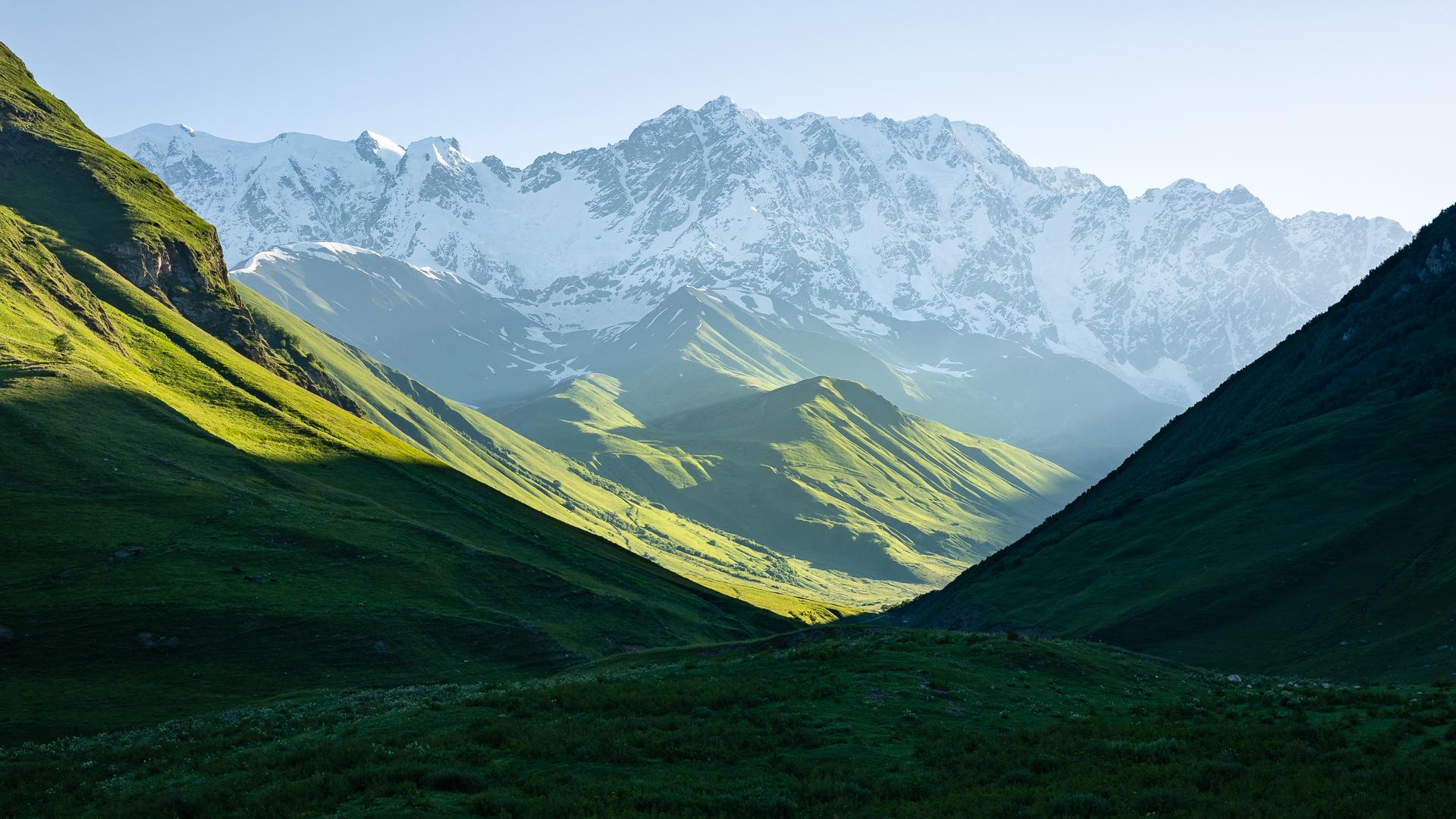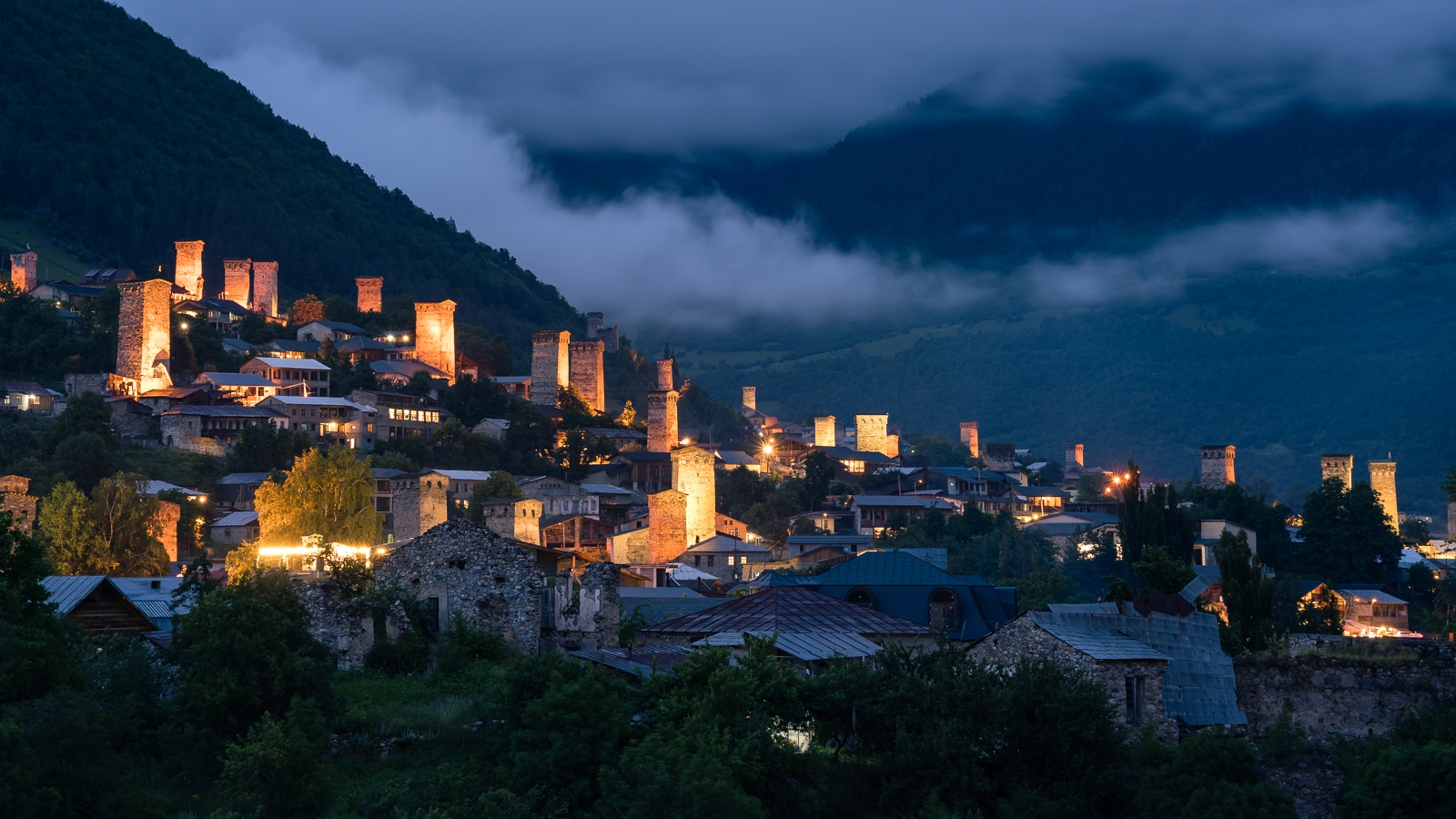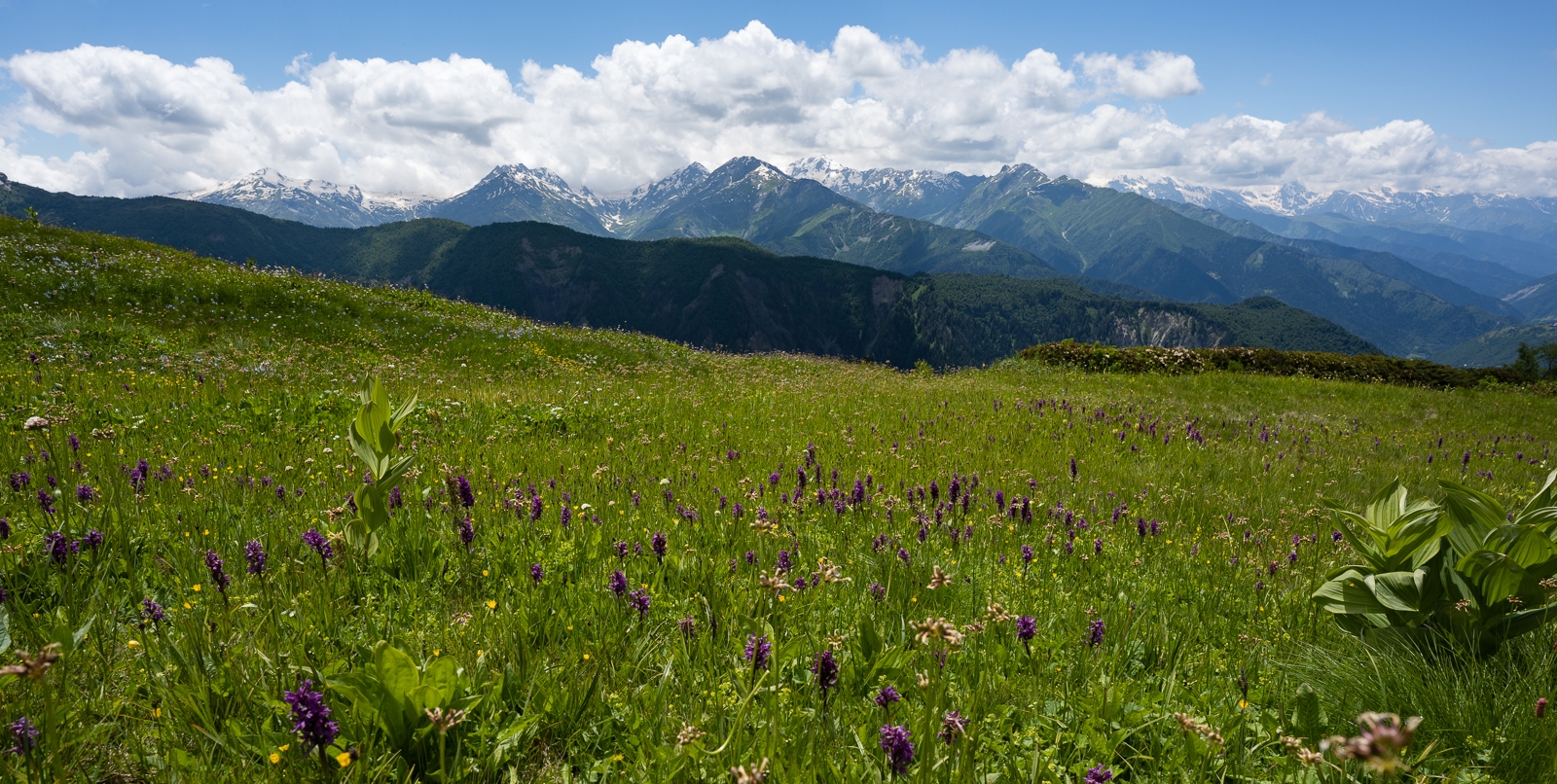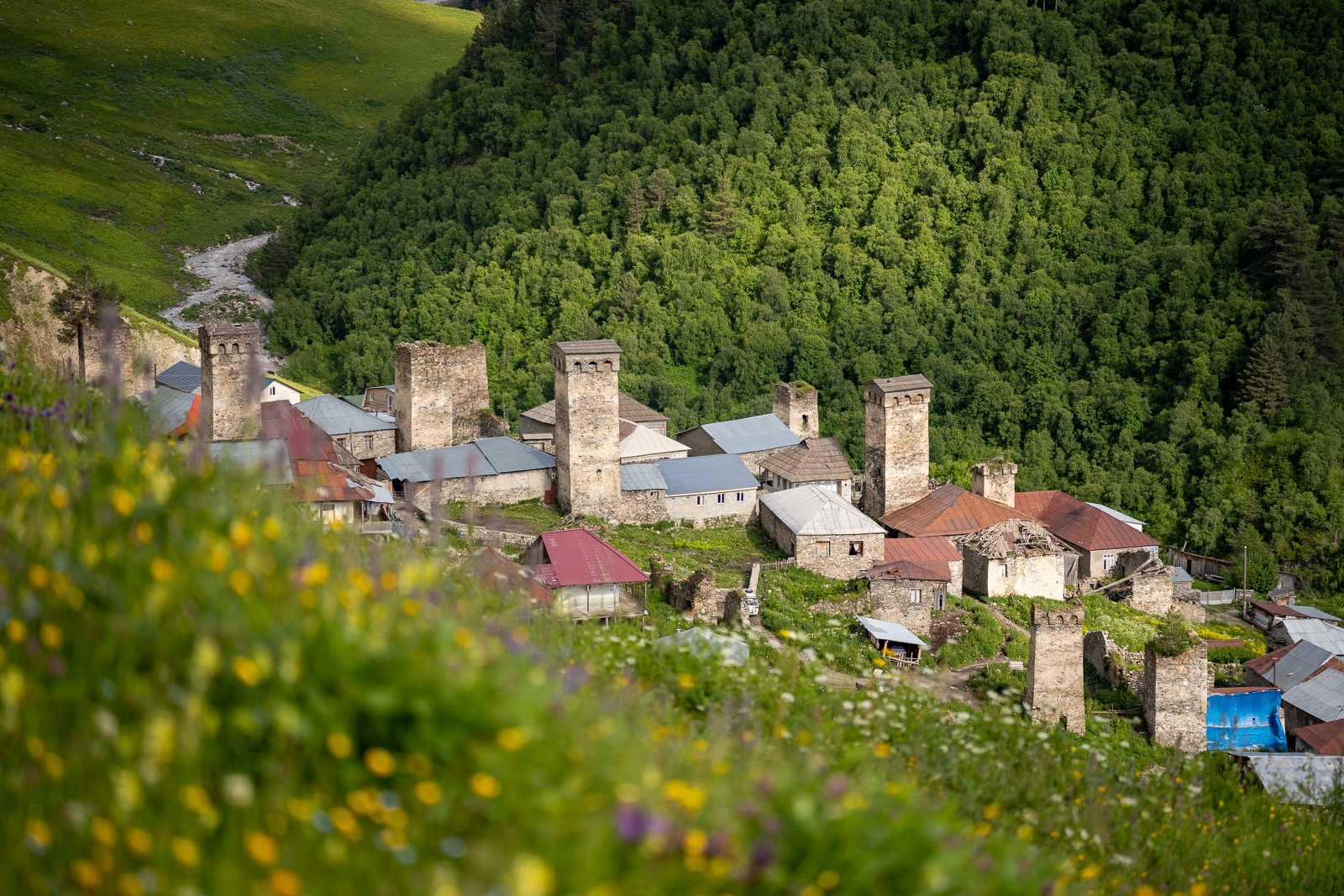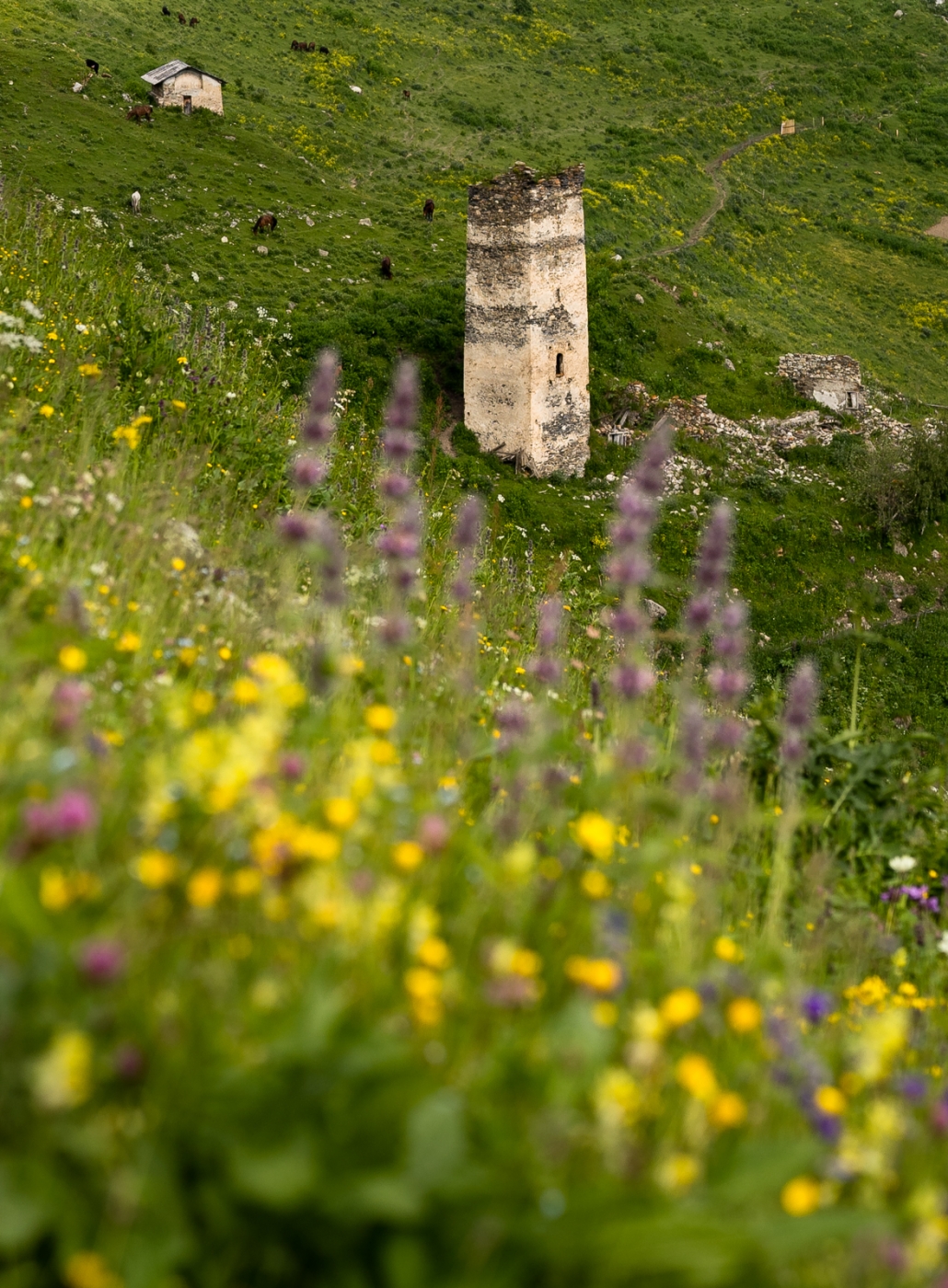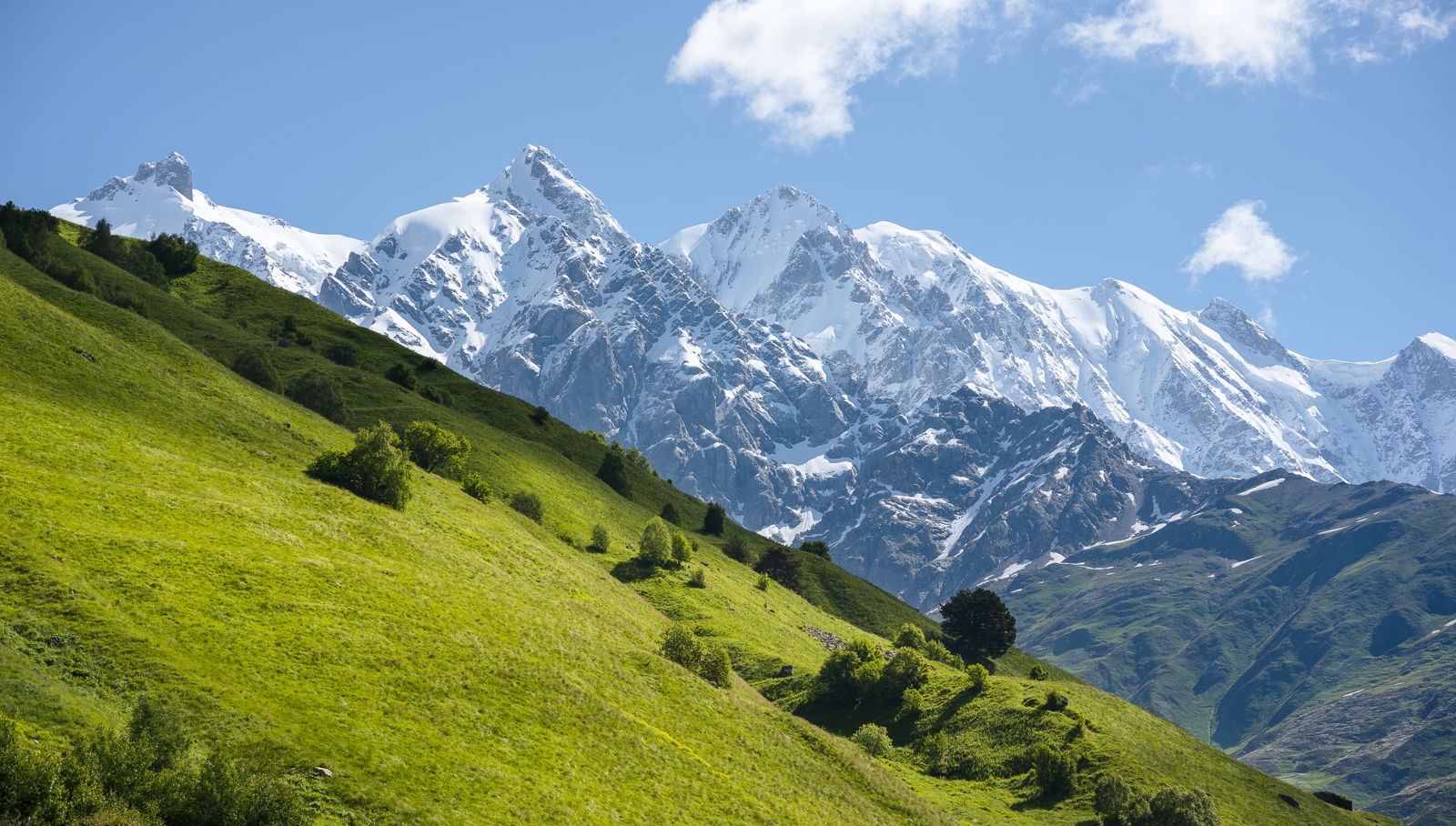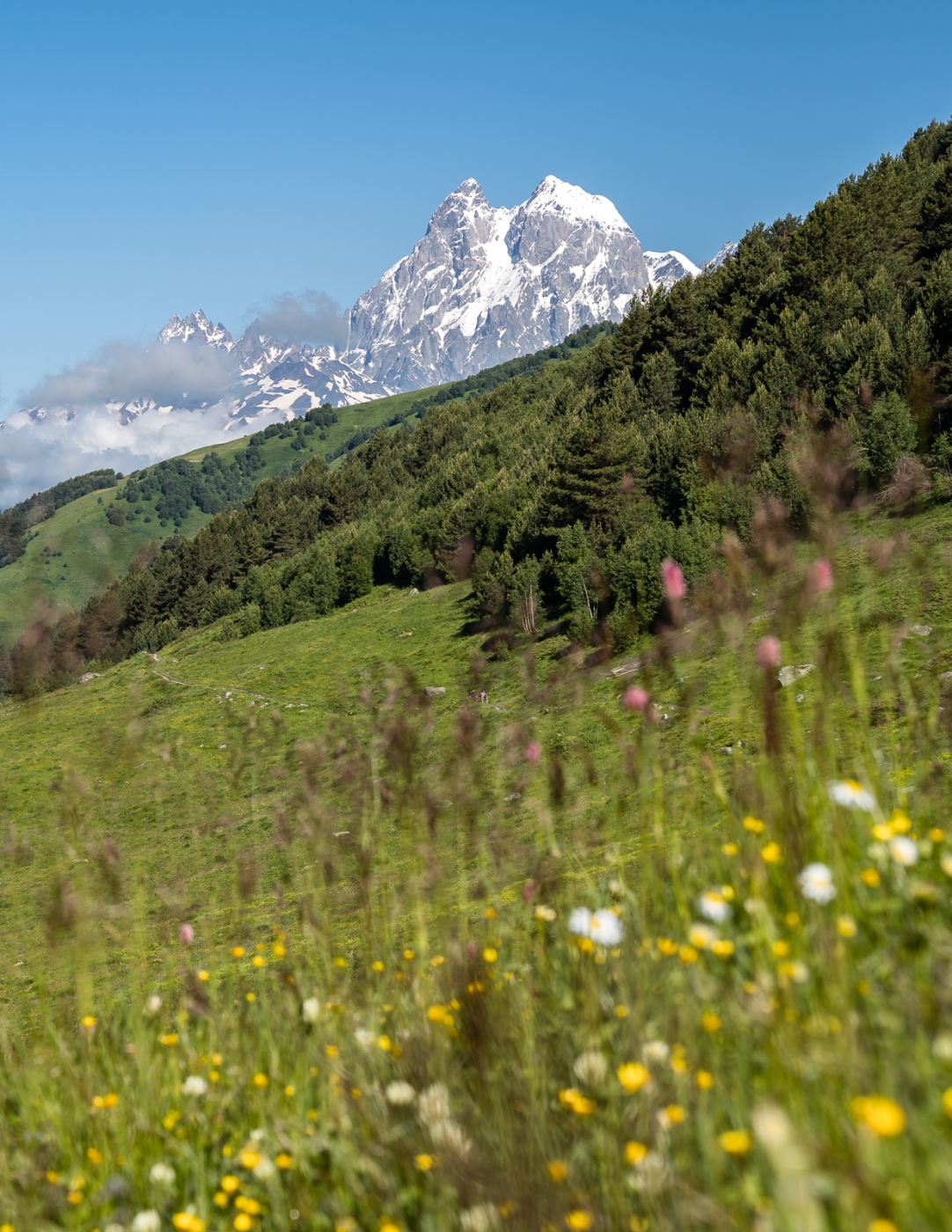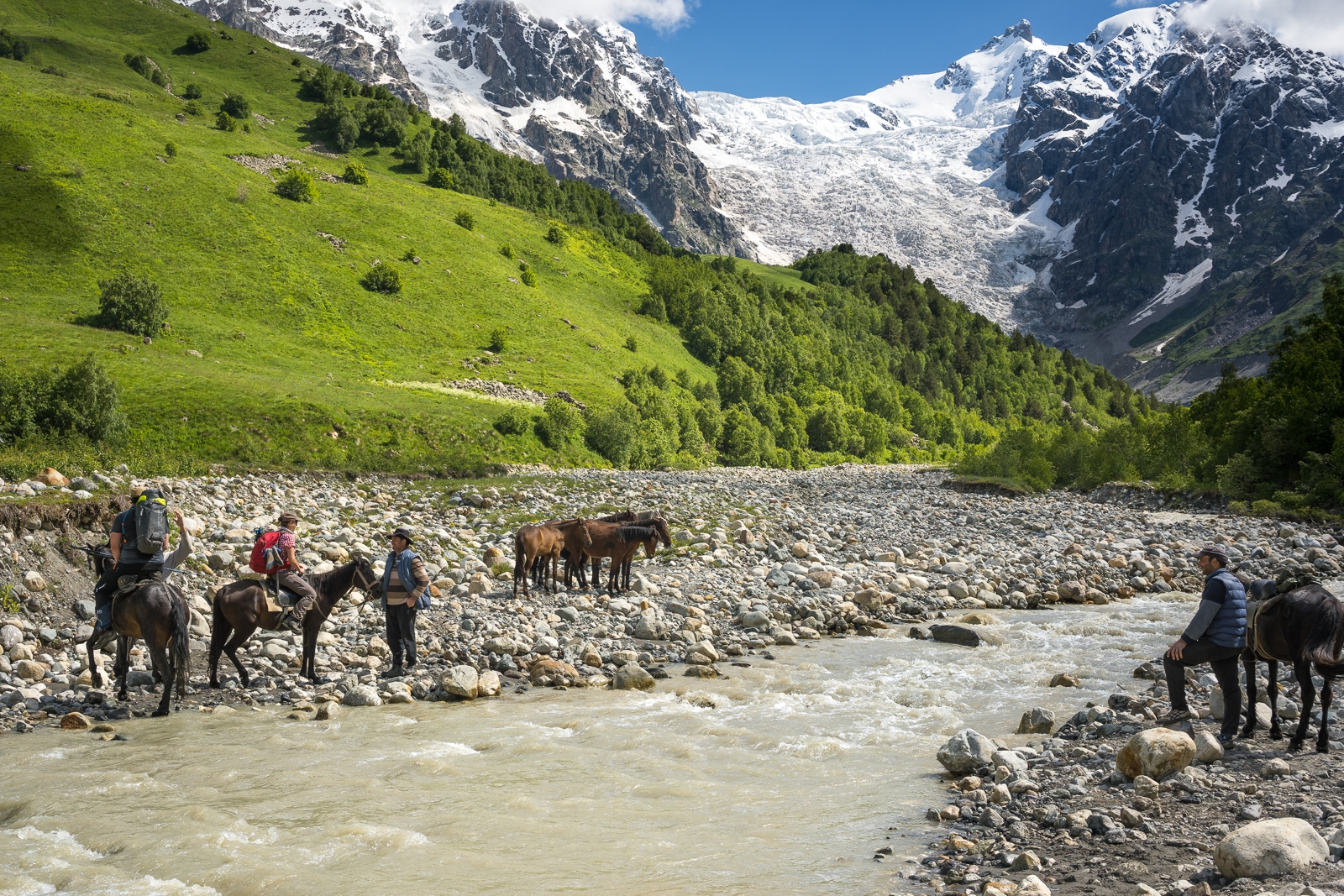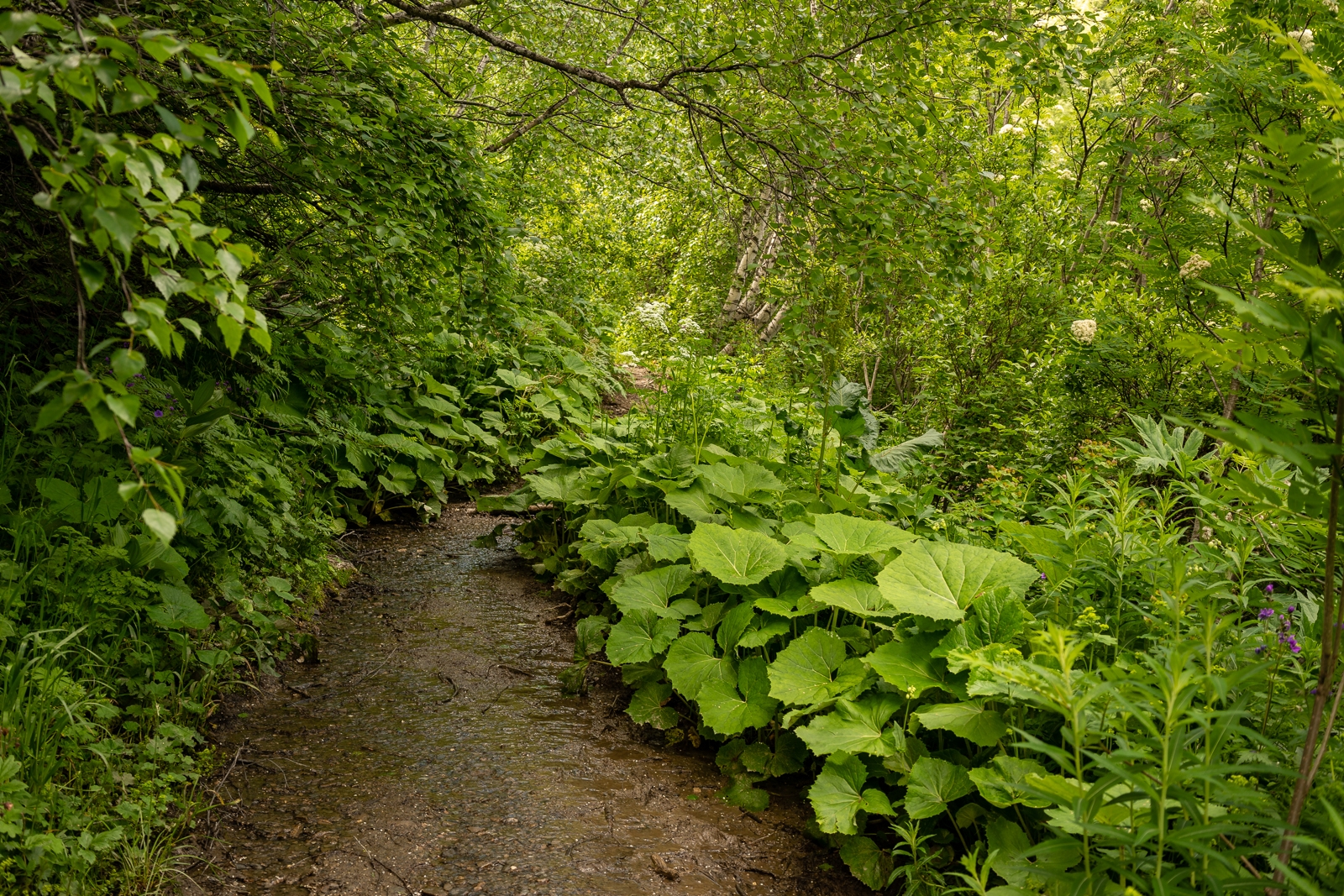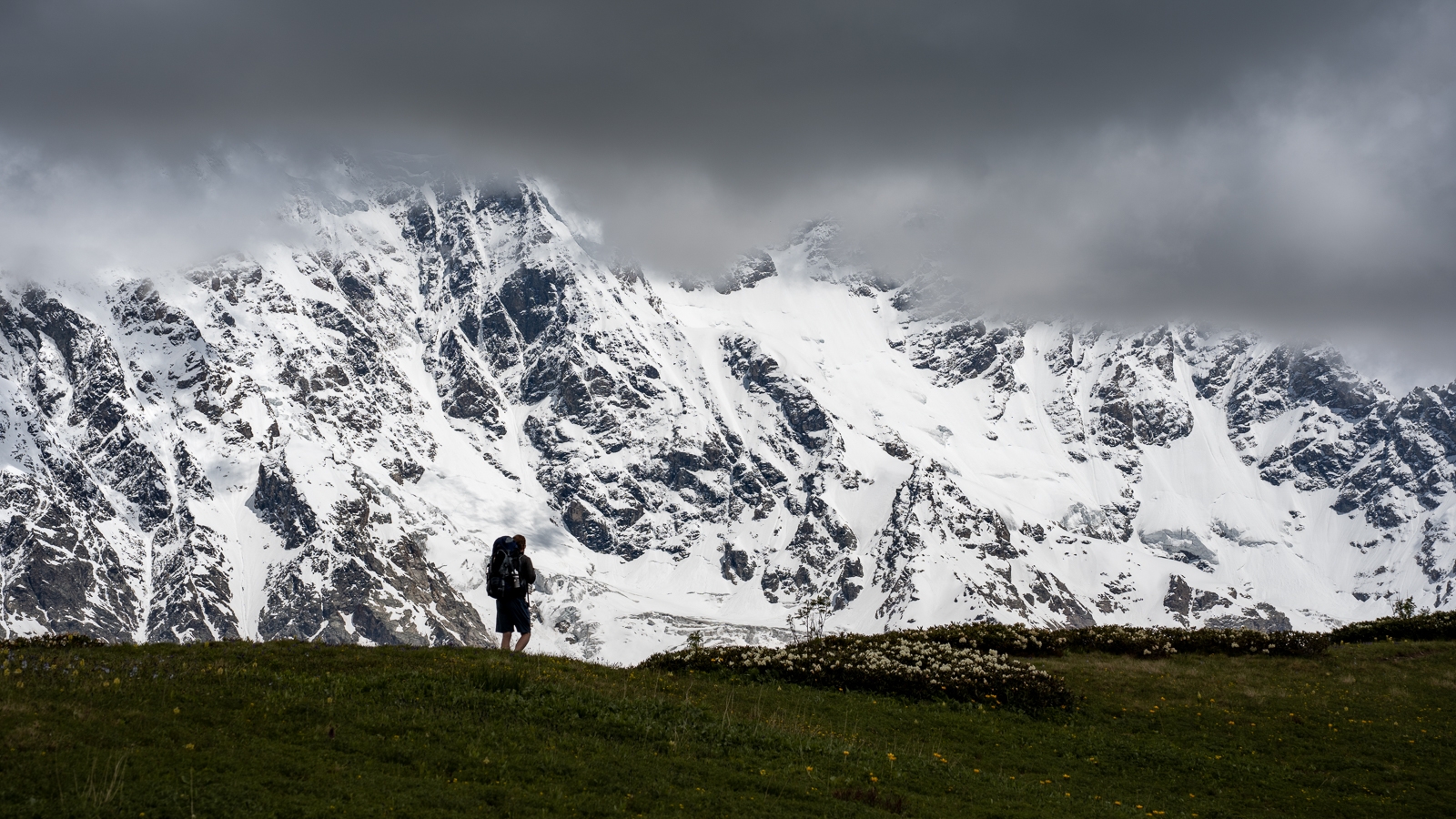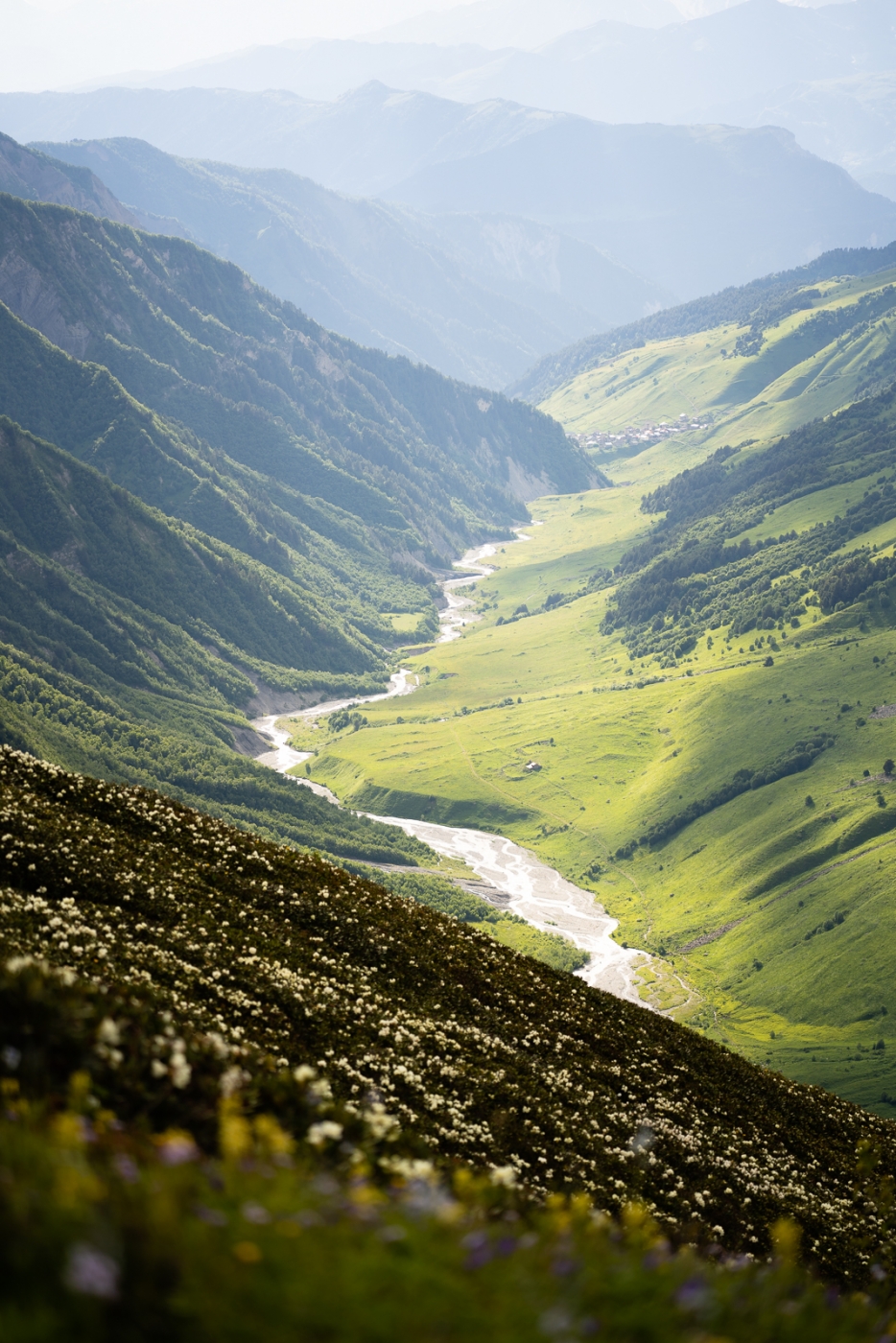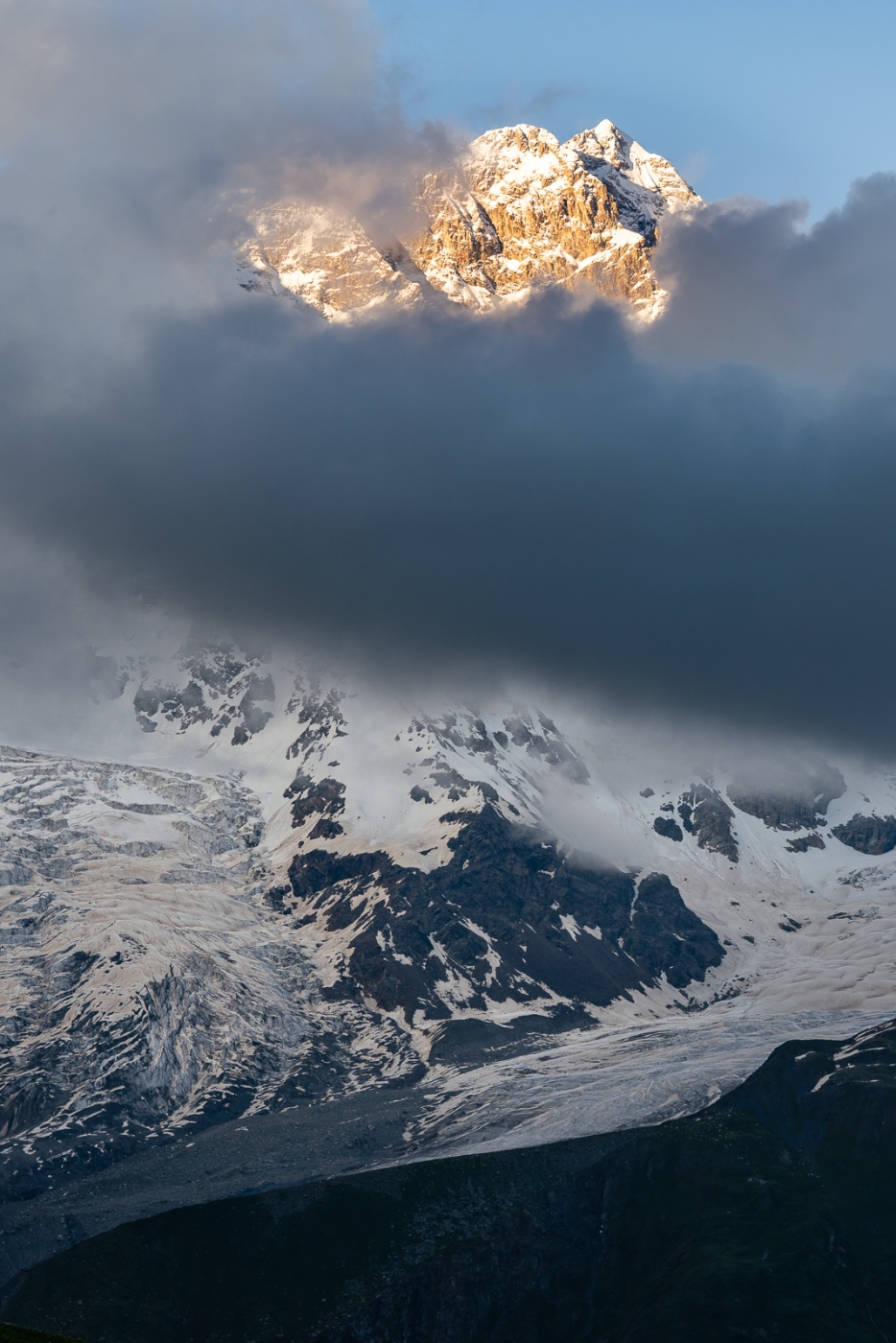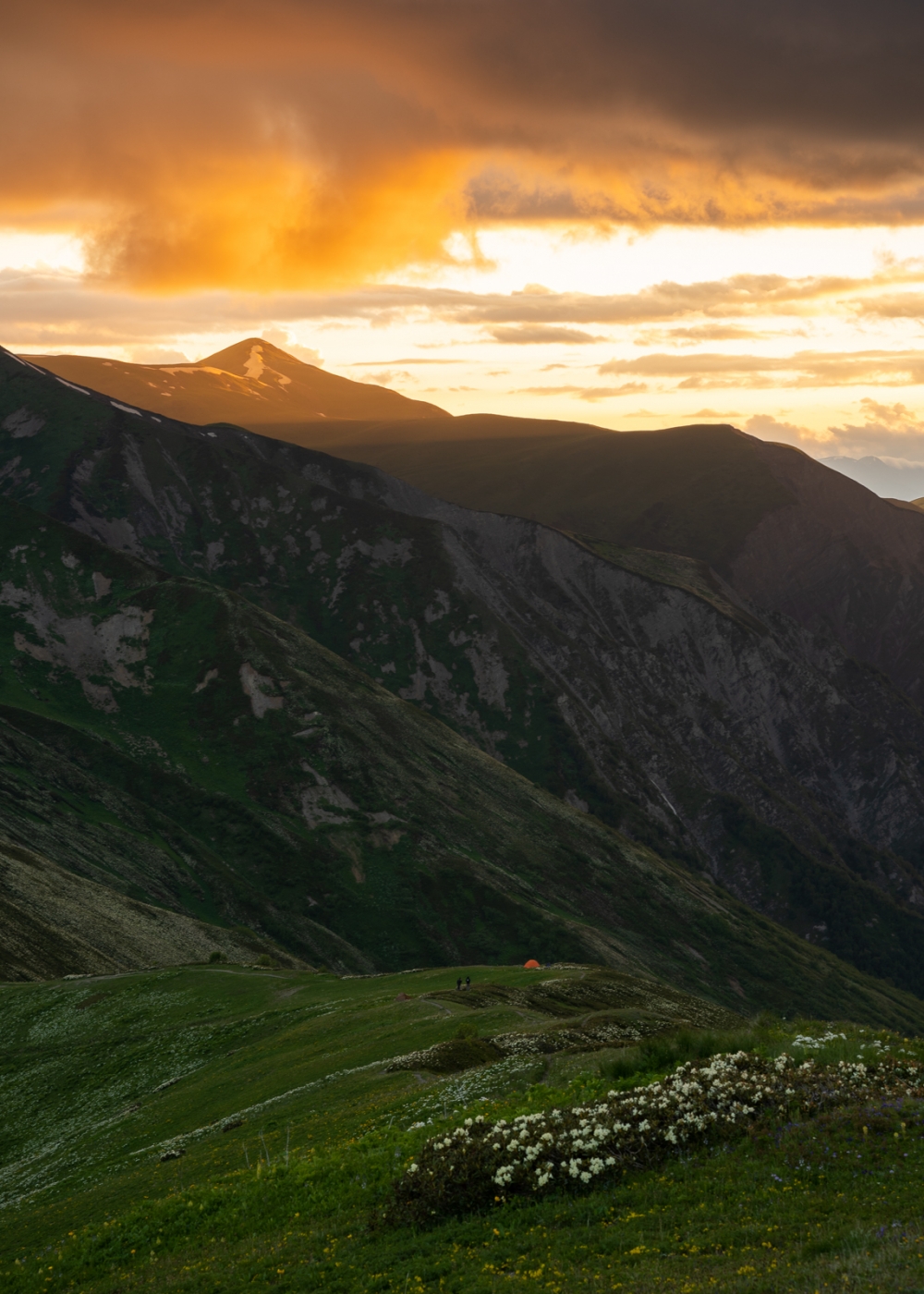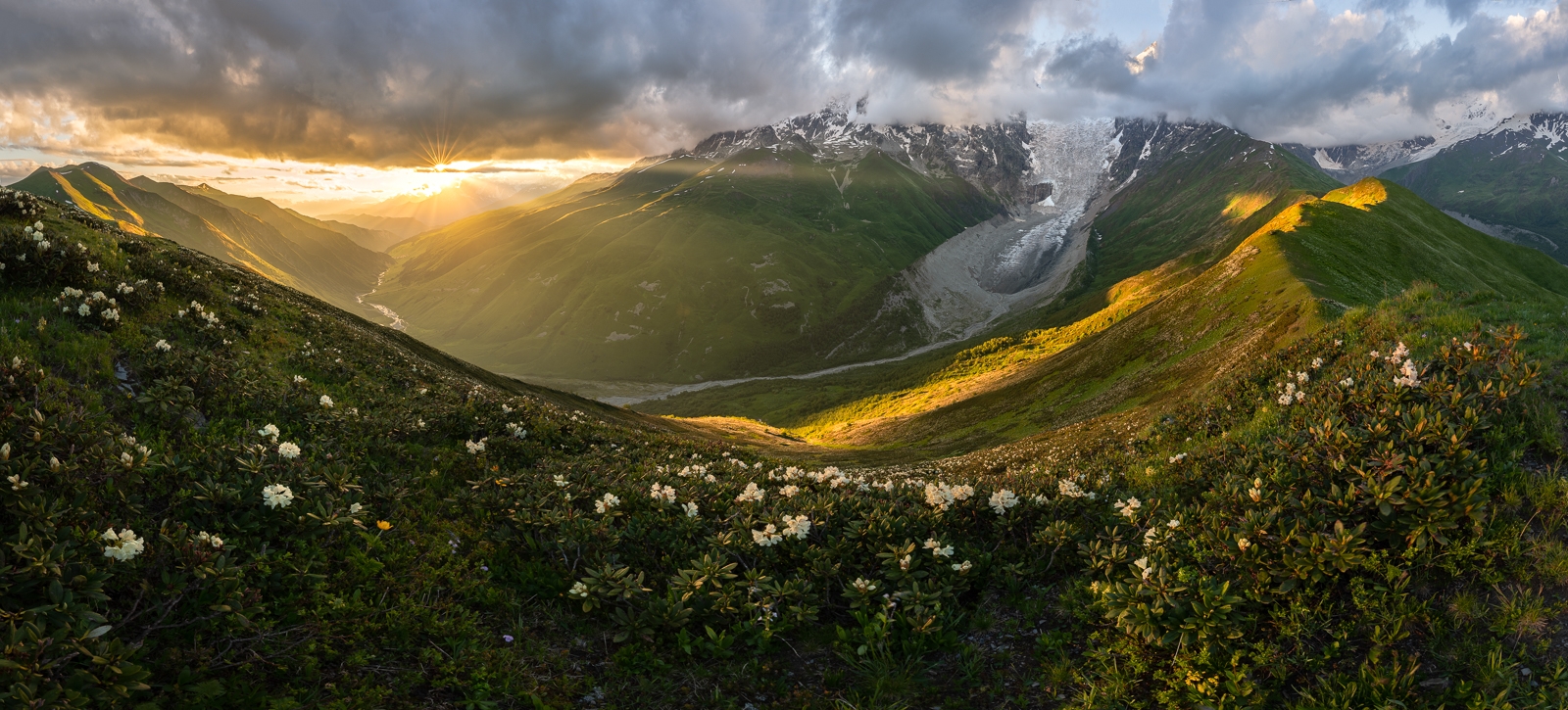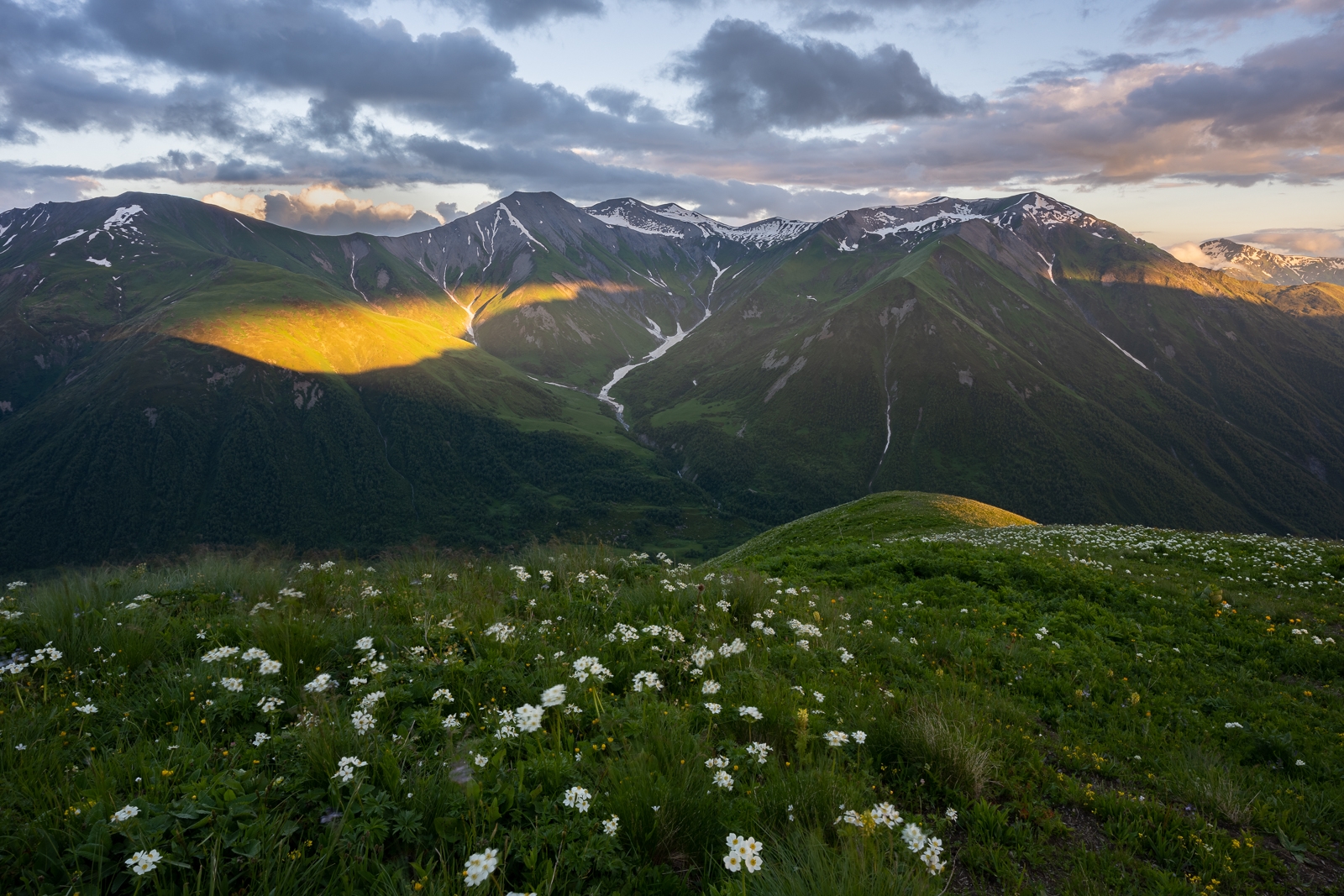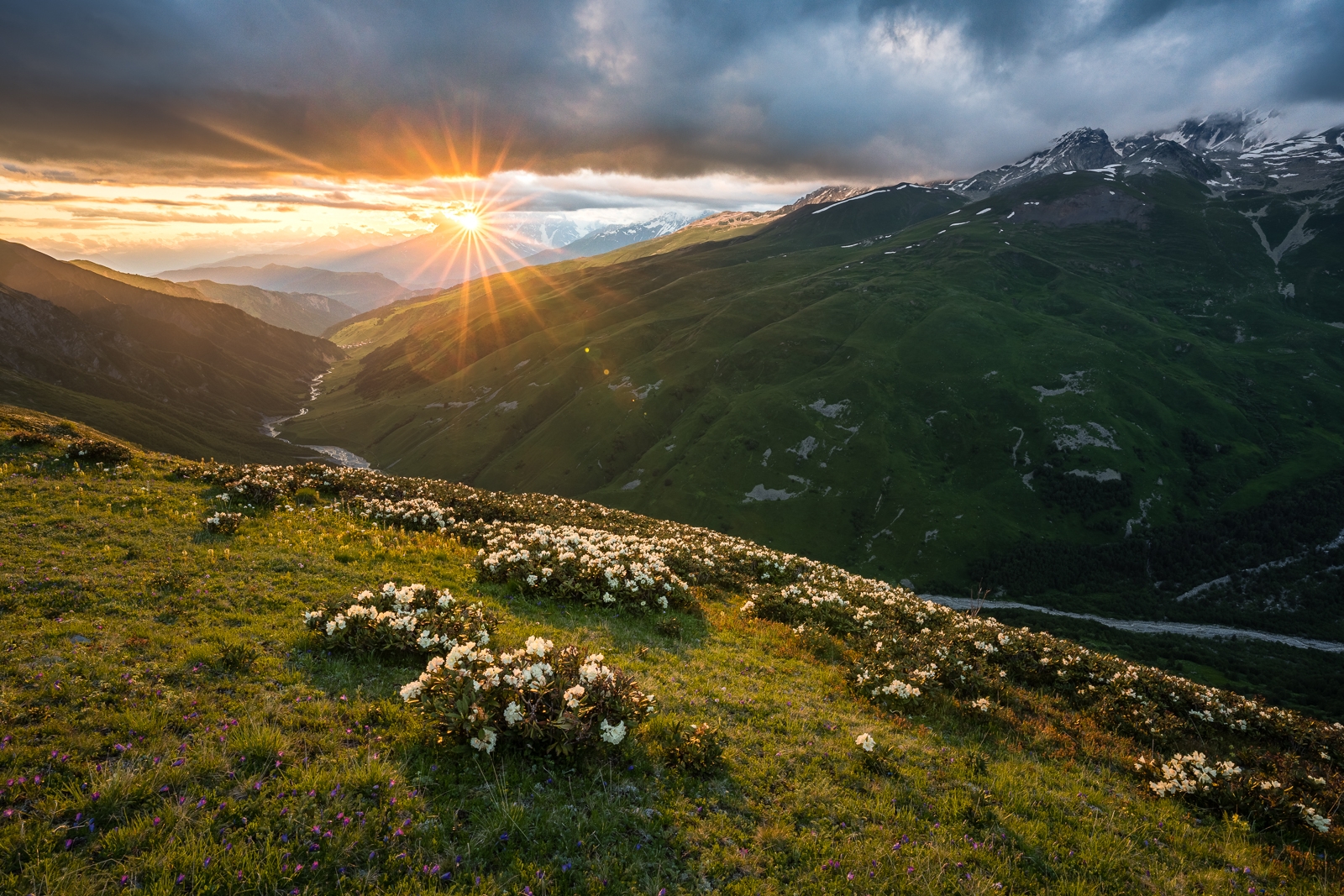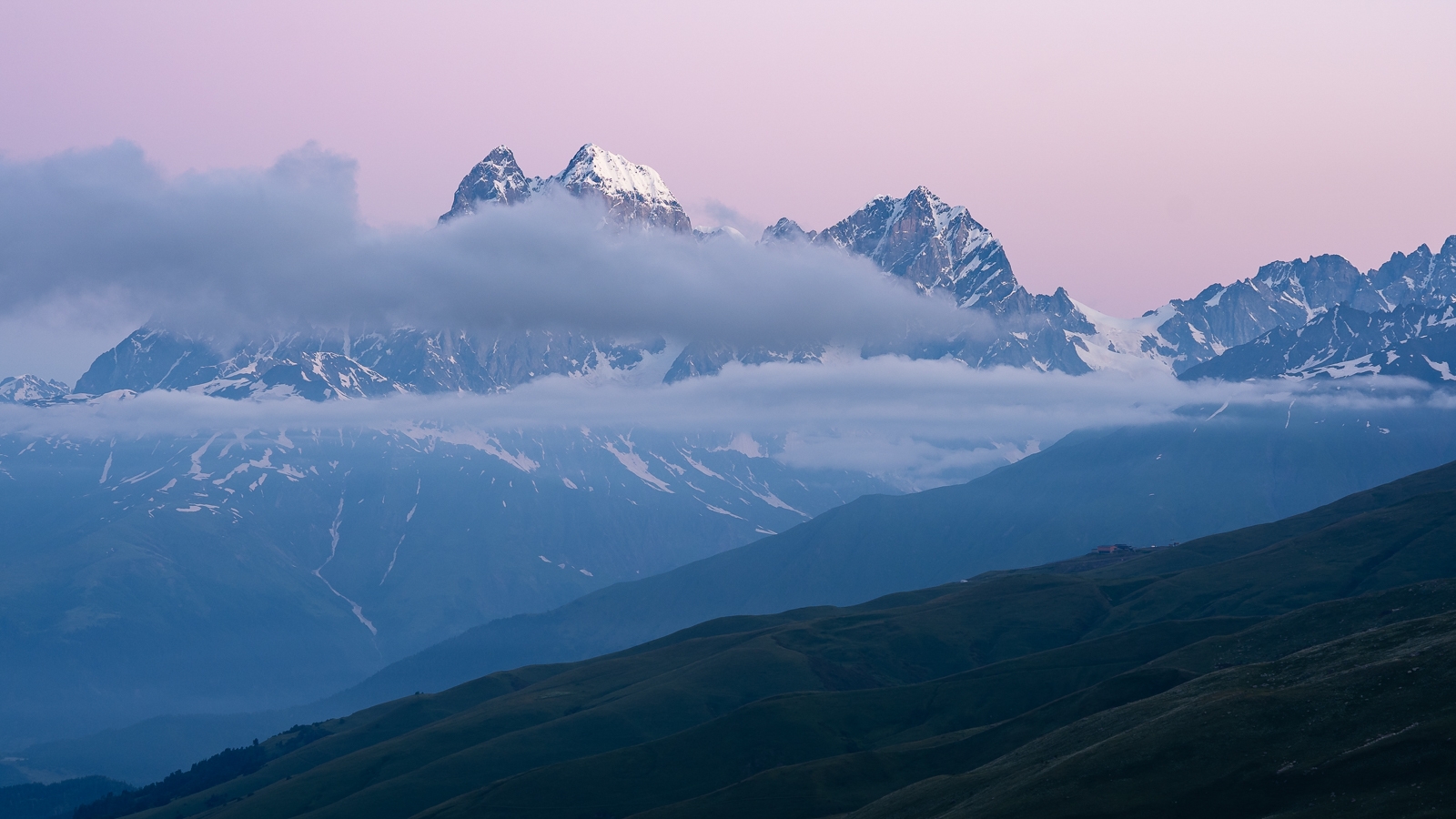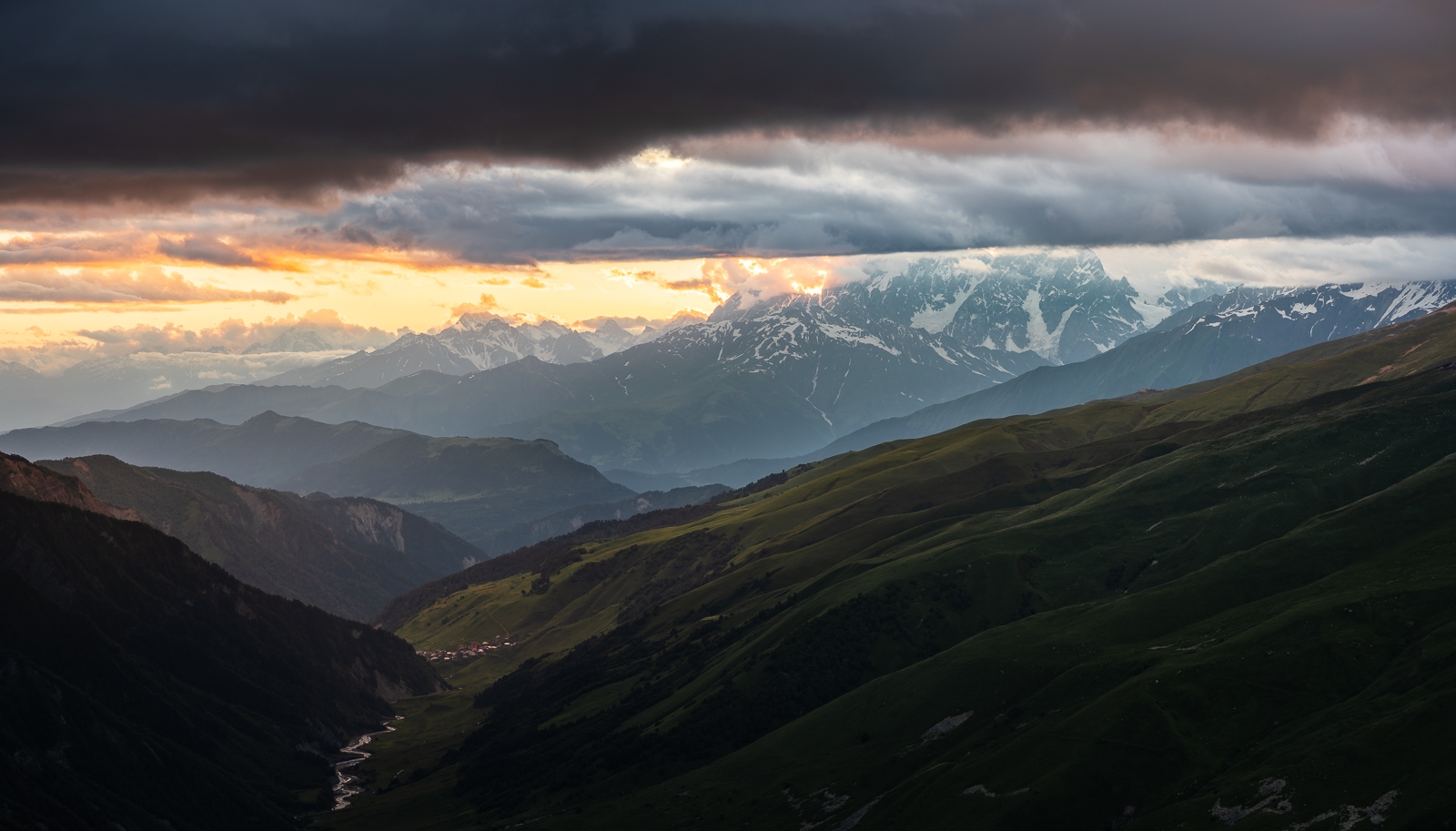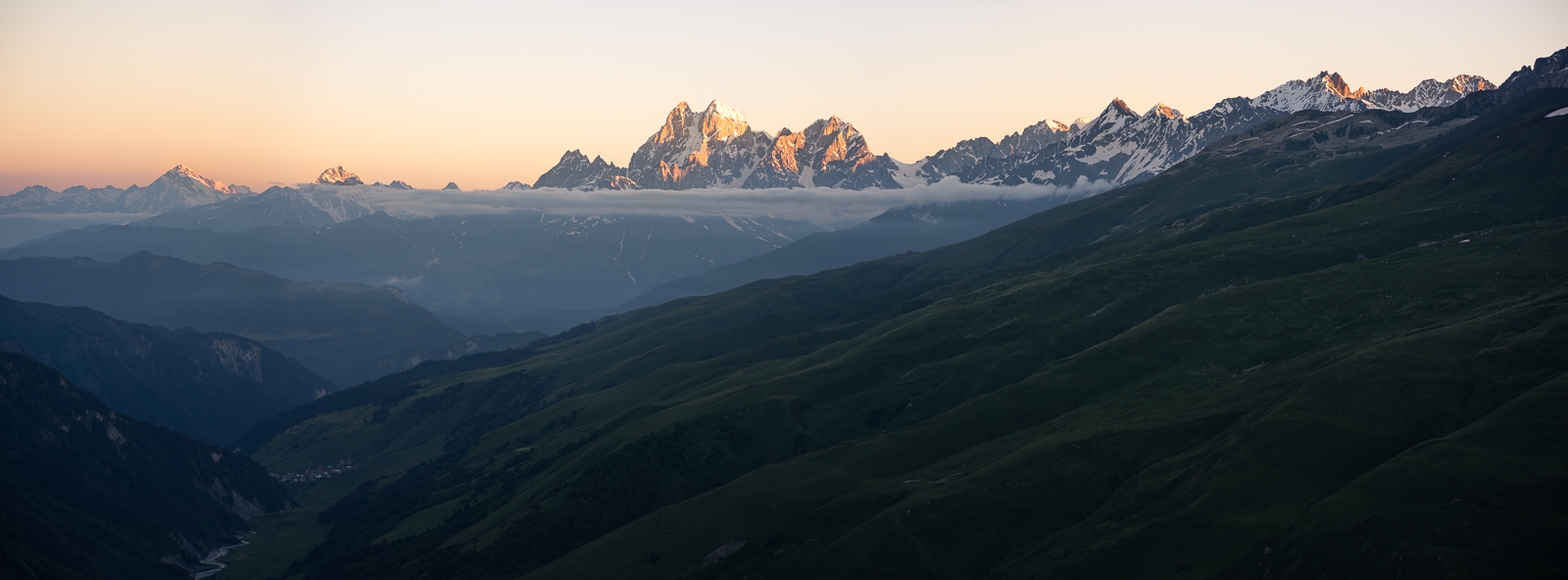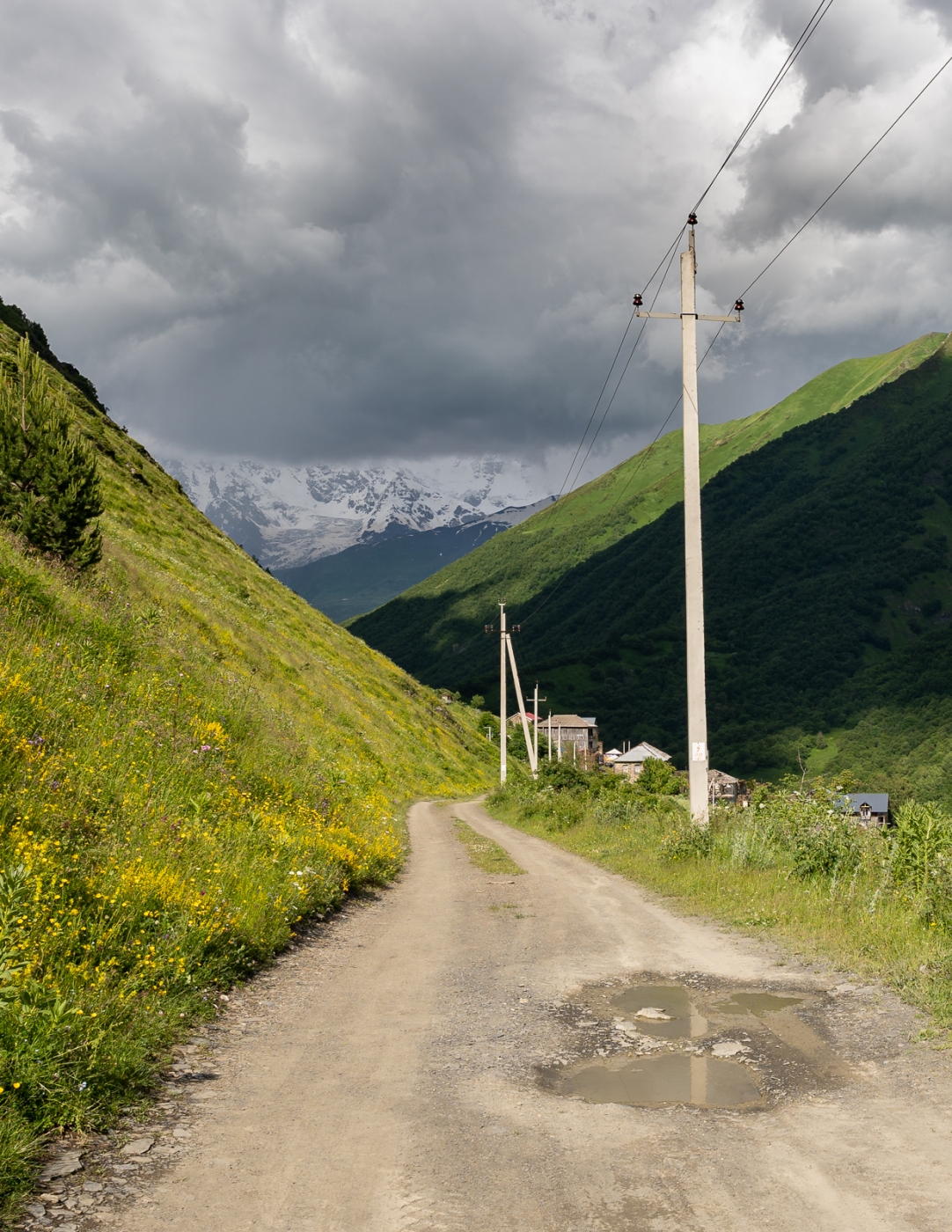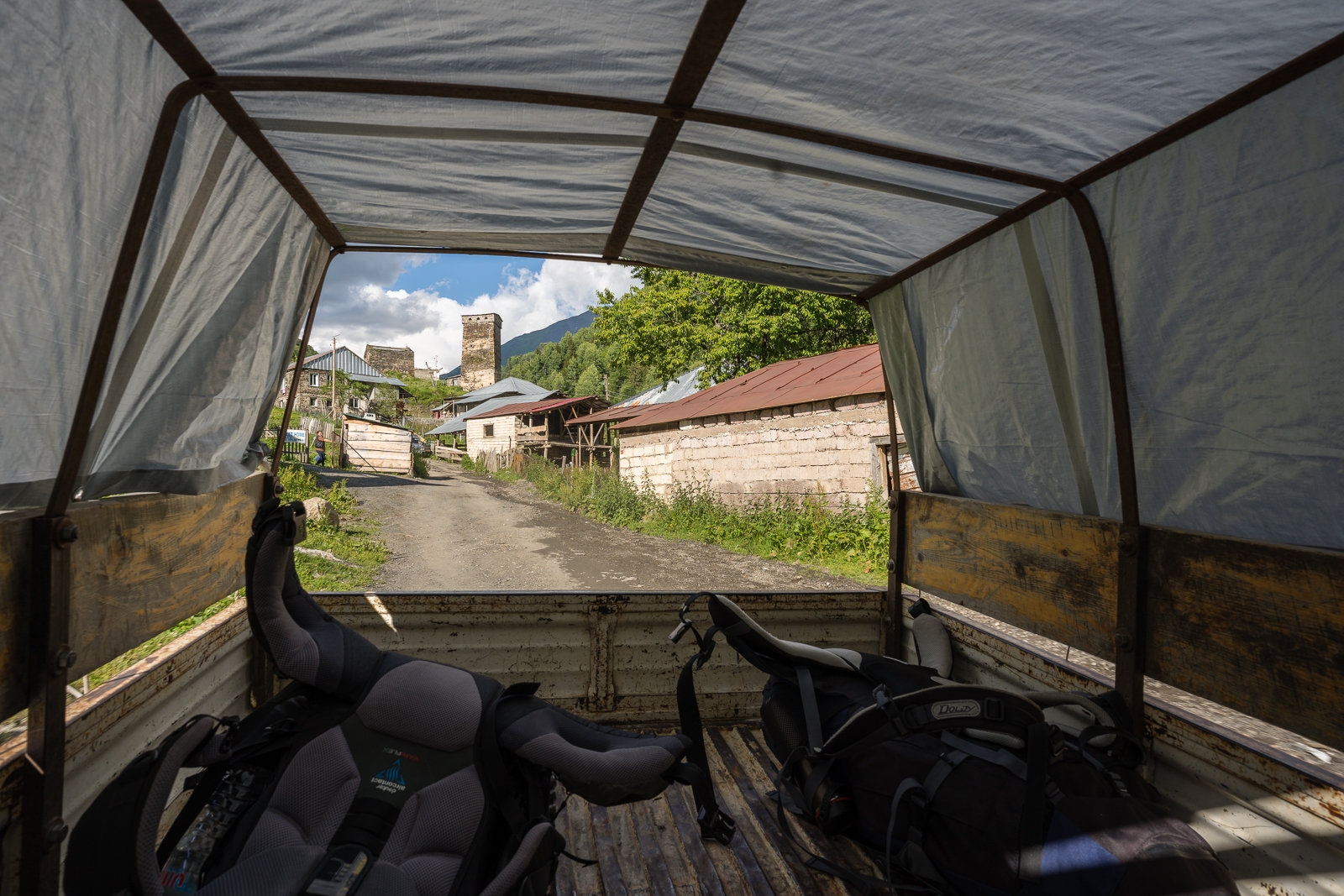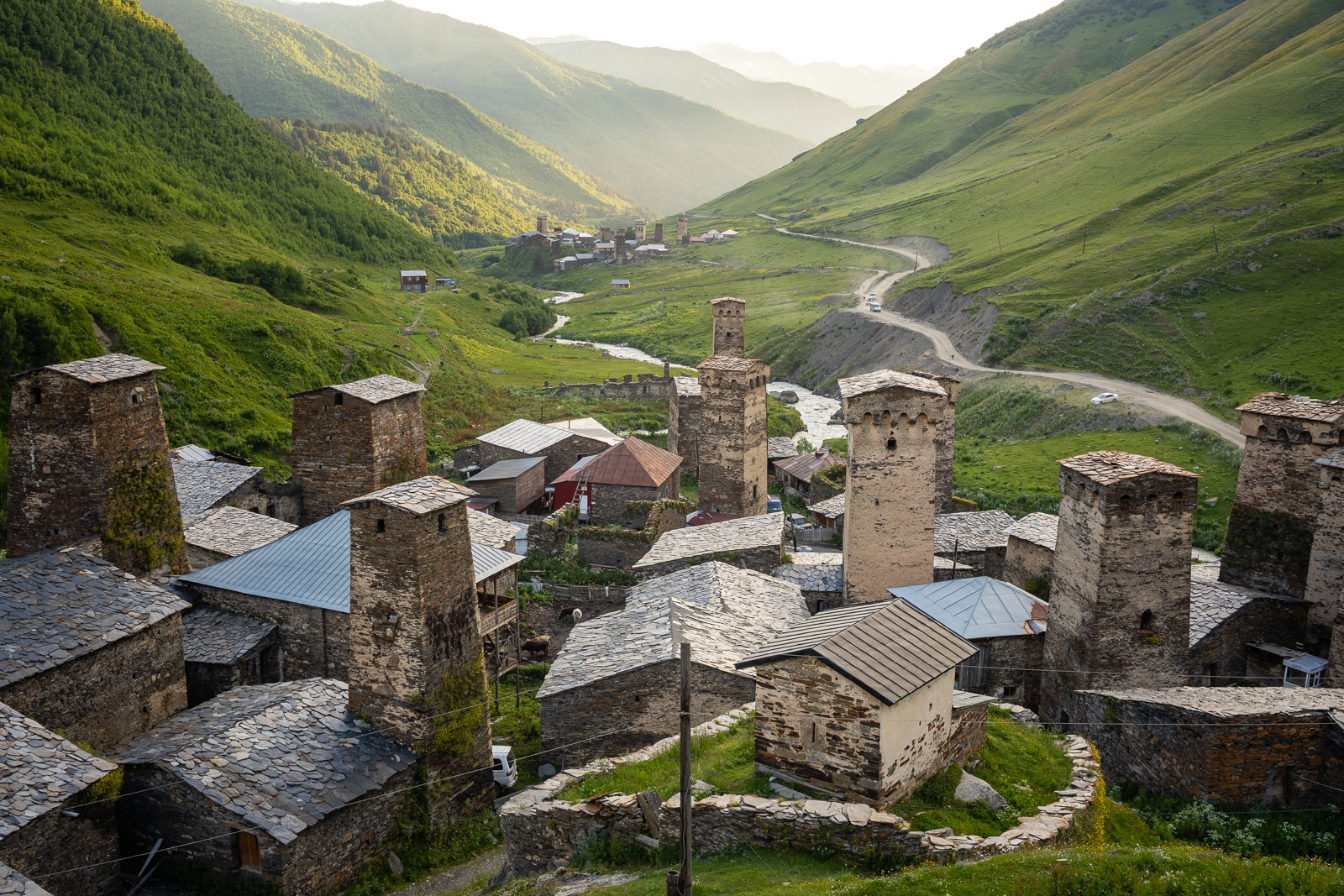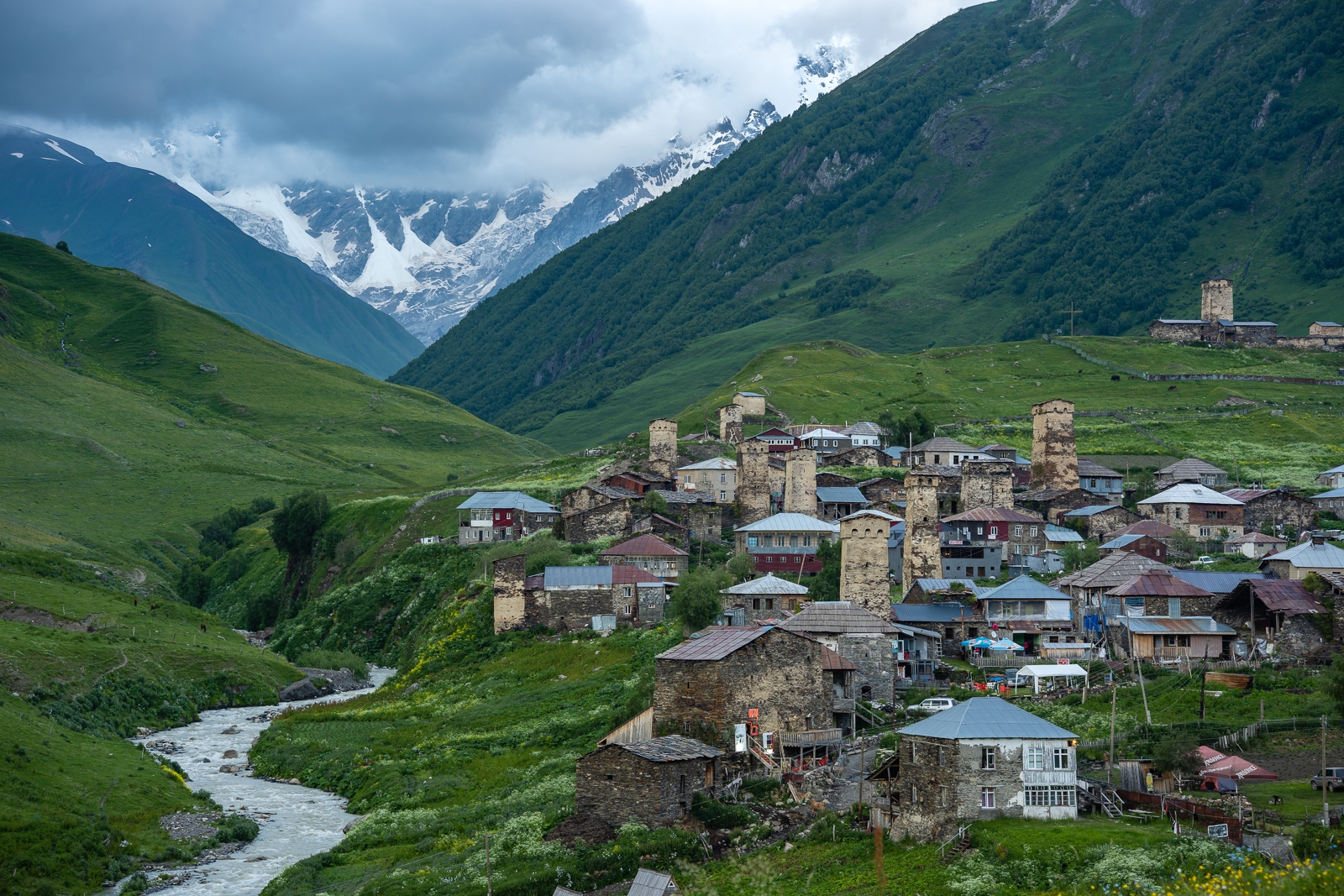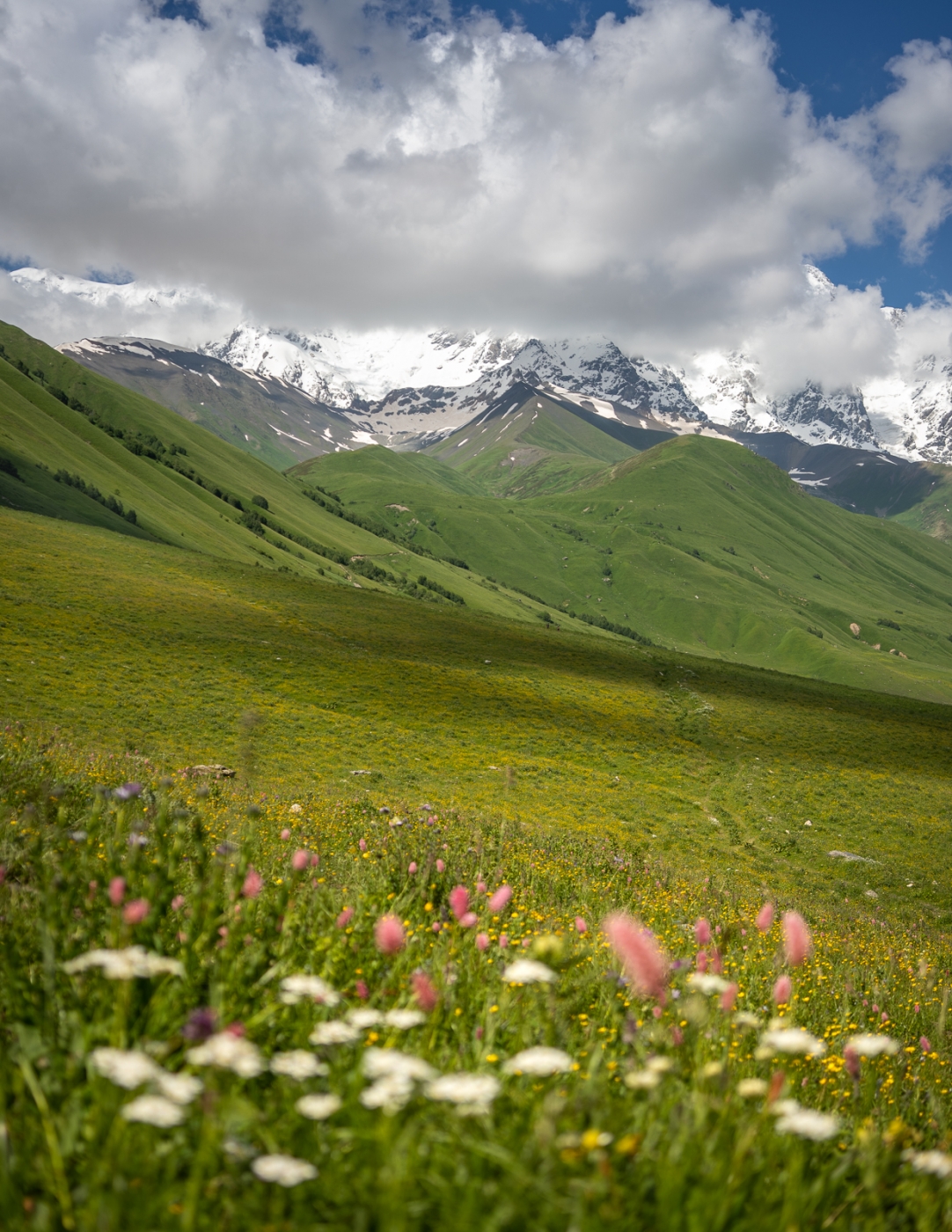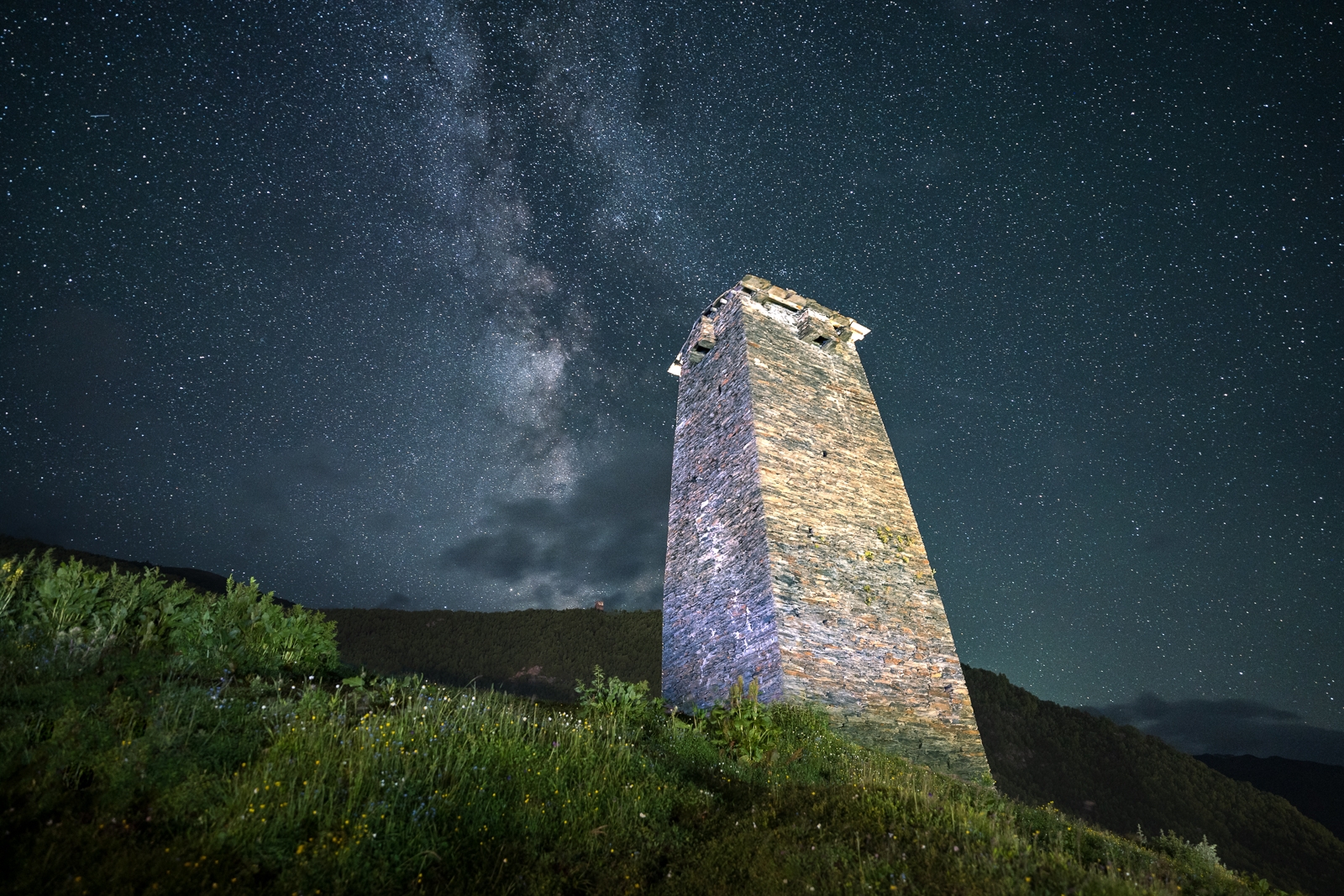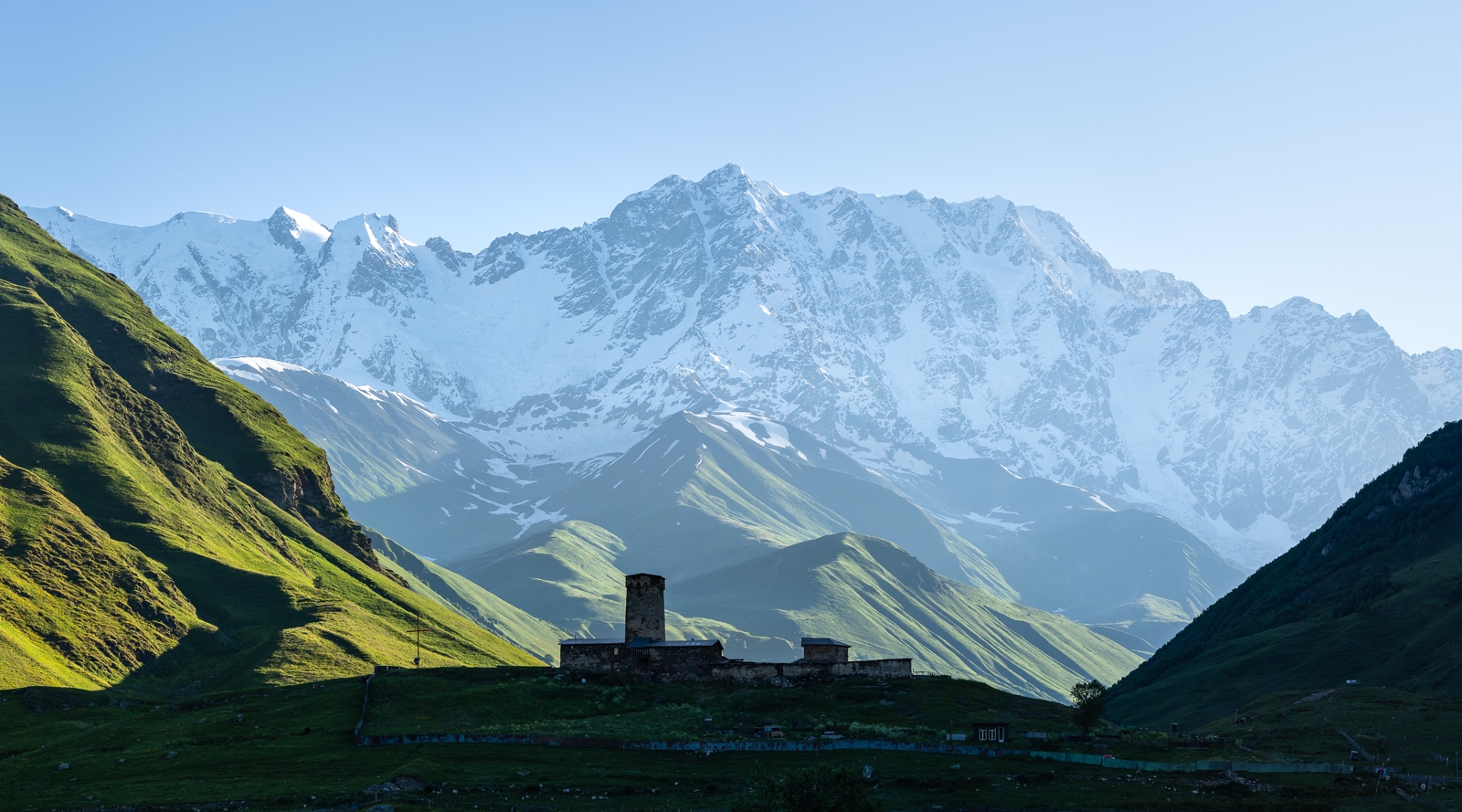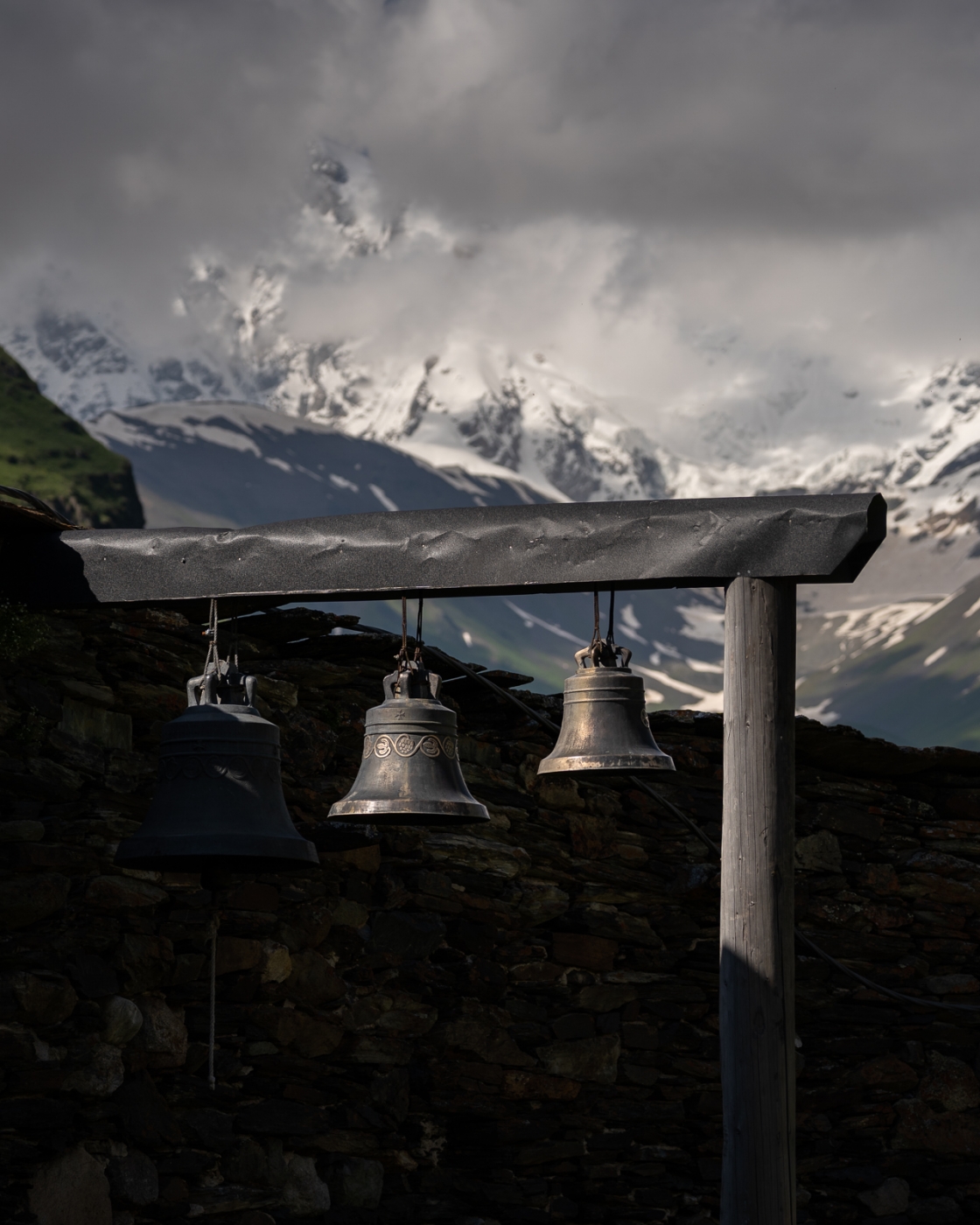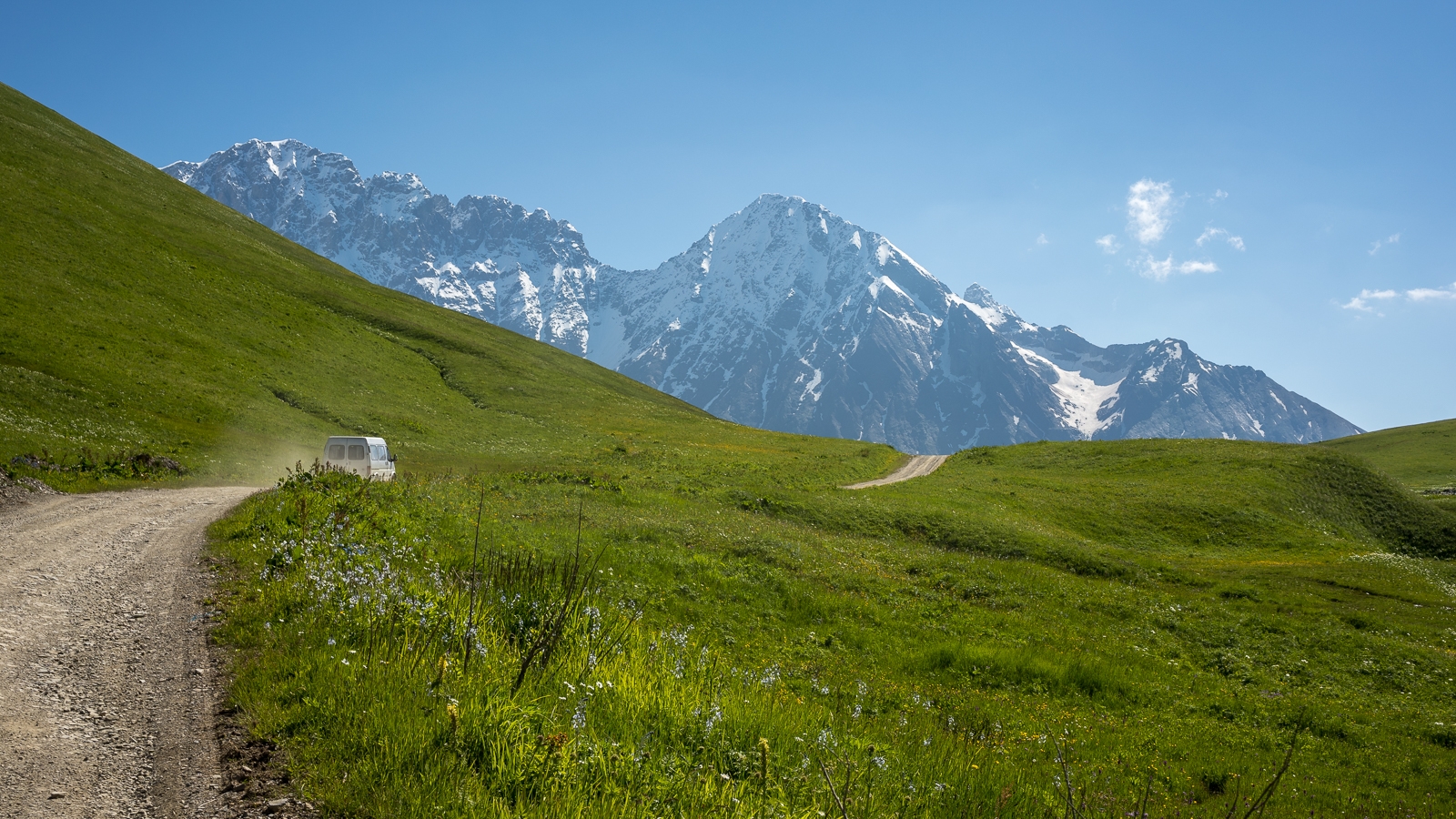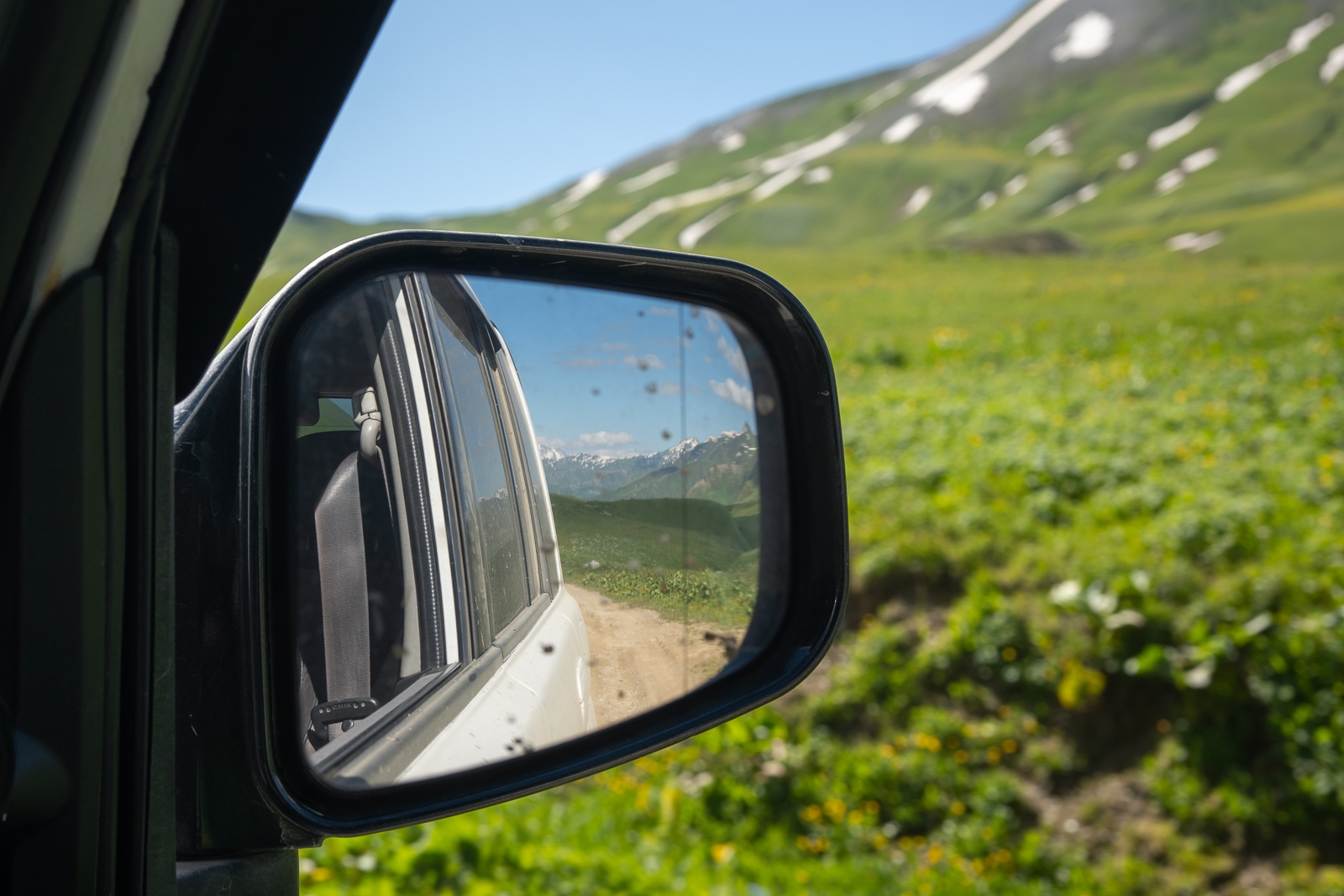Svanetia: through the Caucasus on foot, by jeep, in the back of an old van and on horseback. A night under the five-thousanders. Mountain villages full of ancient stone towers. Children throwing stones or offering to buy mountains. The ubiquitous dogs. The cave-in on the main road and the forced journey over the mountain pass.
Under the wheels of an old Mitsubishi SUV, the first kilometres pass, the car occasionally stutters on the panel road. We pass monstrous steel bridges and empty concrete compounds, the first settlements with half-empty houses. Around them stand old trucks in various stages of decay, the houses connected by a network of yellow gas pipes. Slightly surprising are the palm and banana trees growing among the Soviet relics.
The road turns north, towards the mountains. Somewhere ahead, the Greater Caucasus darkens in the clouds. The road to the historic region of Svanetia shines on the map as a main road, but a jeep is useful here too. Above the Enguri Dam, the road begins to climb steeply, the panels often broken or missing entirely. A herd of cows has to be avoided at almost every bend. The Caucasus welcomes us with rain, streams of water roll down the road, but when the first stone Svane towers appear on the slopes, the sky clears and a rainbow shines between the mountains.
Mestia is the first true Swabian settlement and the largest. Perhaps every house has an ancient defensive stone tower, an ancient symbol of the abilities of the local people. In the evening, the towers are beautifully lit up, and the progress of tourism has seeped in. Most of the houses in town offer some form of accommodation, not surprisingly, in winter there is skiing and in summer this is the start of what is probably the most famous Georgian trek leading to the settlement of Ushguli, which is also where we are going.
We leave the car in the village behind Mestia with Mr. Givi. After an initial introduction, which is done thanks to Martin in Russian, he lets us in the gate and starts to tell us his story. He used to be an aviator, now he hunts game and offers accommodation to tourists here in a valley at the end of the world. It used to be better, he says, with dozens of Czech tents on the hillside behind the house, but the wars have meant that the tourists have dwindled. He smiles when he sees our full backpacks, many people no longer go here for the hard labour, rather they take advantage of the ubiquitous guesthouses. When asked about the weather, he replies that it's hard to predict now, the missiles fired in Ukraine are said to be bringing clouds here to the Caucasus. And it's only a matter of time before war is here again. He laughs when he says that all the planes have to do is fly over the mountains and Svanetia will be occupied, but there is a grim irony in his laughter.
But the sun is still shining here, we say goodbye and climb up towards the mountains. We leave behind a valley full of stone towers and herds of cows, and meadows begin to bloom above the forest. Perhaps it is the southern orientation of the Georgian part of the Caucasus that makes the meadows here so rich. I don't know if I have seen so many herbs with flowers of all colours anywhere else, probably only here. The first snow-capped peaks appear above the meadows, somewhere to the southeast of us, but the highest border mountains are still hidden.
We head for the mountain village of Adishi, another typically Svanean one - full of stone towers. The road plunges into the forest a few more times, you have to cross a ford of a wild river or cross an inclined footbridge, descend between the last trees to an open valley. The settlement is not visible until the last moment, when the first stone towers rise around a bend in the terrain, followed by the tin roofs of small houses. In the afternoon sun, the whole valley seems fabulous.
However, the local order is (fortunately) still in the uneasy past of a remote mountain village and hard life. The electricity is out all day long, and when it comes on, there's an uproarious cheer from all the houses, only to have the power go out again five minutes later, for the whole night. The whole village is dirty, crumbling, but in that beautiful way. Cows move freely among the houses, horses graze on the slopes around, already free from their duties by evening.
The trek from Adishi continues comfortably through the valley, along a wild river flowing from the white glaciers. But before the glaciers ahead appear, the peak of Ushba, the symbol of the Svane mountains, rises above the green hillsides on the opposite side. As the valley widens, the whitish peaks of the four thousanders, so close and yet virtually unreachable, light up directly above. In the morning sun, they glisten against the flowering hillsides.
At the point where there are more rocks in the river bed, the path turns and crosses the wild stream of water. Perhaps it would be possible to cross it, but local enterprising people offer a simpler solution. They are already waiting with horses at the ford and offer a comfortable transfer. After some initial apprehension, I climb into the saddle, which one of the fried horsemen appreciates with the sentence "Maladec, very good!" and a few moments later we are standing on the other side of the river. In the afternoon the river is so swollen that it is insurmountable even for horses.
The trail from the ford climbs steeply up to the Chchunderi saddle, through lush Caucasian vegetation. The Adishi glacier glimmers through the birch branches, while the peaks of the bordering mountain range huddle in whitish clouds. Just below the saddle, at nearly 3,000 metres, the breathlessness of the mountains is overwhelming. Perhaps the altitude is partly to blame, perhaps the views that open up even back across the valley to Usba. From the saddle, the trek heads back down into the valley on the other side. Most people descend here again to take advantage of the hospitality at the Chalde or Iprari settlement. Our plan is different, however: continue up the side ridge a short distance, find a place to camp and spend the night directly below the glaciated peaks.
We find a level spot on a peak surrounded by yellow and white flowering rhododendrons, from where the grassy ridge undulates in pretty curves to below dark rocks and ridges covered in perpetual snow. Now in the afternoon it is shrouded in clouds, with only an occasional peak peeking out to immediately hide again. It seems almost absurd how high above us some of them tower.
Evening brings heavy clouds, shrouding almost the entire mountains, with only a permanent window remaining over the Adishi glacial outwash. To the west, however, a strip of clear sky remains, the sun sinking and eventually conjuring a dramatic scene of contrasts from beneath the clouds. Two more tents appear in the saddle below us; someone had a similar idea to stay high in the mountains for the night. We wave to each other, enjoying the Caucasian spectacle. By this time the afternoon heat is long gone, replaced by an almost freezing evening. Just as the sun seems to have set for good, the clouds break over Georgia's highest mountain, Ushba, and the sun illuminates its snow-capped peak in orange.
At night, I look up at the night sky hoping for a starry sky undisturbed by light smog, but it is cloudy and for a while it even starts to rain. The clouds over the mountainous landscape are strangely heavy this way at night, I feel almost faint from the openness of the landscape covered with a heavy lid. Or is it the altitude?

An icy morning at the bivouac site. On the left, on the horizon, the pointed Usba, then the prominent Tetnuld. The Adishi glacial outwash, with the Gistola peak rising above it. Katyntayu and Lakuca-Laartkol, with the Dzangi massif (West, Main and East) to the right of them. The prominent peak on the right is Shkhara, the highest mountain in Georgia.
In the morning the situation changes completely. The sky has cleared up, a wall of white mountains stands right in front of the tent undisturbed by a single cloud. Far to the right we can see the western, lower, peak of Georgia's highest mountain, Shkhara. Far to the left, in the west, the two-horned Ushba breaks through the last clouds and welcomes the first rays of sunlight. To the right, in the distance, the seemingly tiny western peak of Elbrus even rises above the wall of mountains. It's freezing, I can feel the chill in my fingertips, but I stay outside. From the tents in the saddle below us, the first overnighters are also peeking out to enjoy the sunrise.
All it takes is for the sun to come over the edge of the mountains, illuminate the tent and the cold of the night fades into oblivion. We descend steeply from the saddle towards the eastern valley, rhododendrons alternating with flowering herbs of all colours. At the river, where the main trail heads further down the valley in the direction of Chalde, we turn left, following an unmarked trail heading towards Lagem Pass. We have no idea if it is possible to cross the river here, or even if there is a trail at all. According to the available information, few people take it, but crossing the pass would save us a boring further stretch along the road and river to Ushguli.
In a meadow full of dead ears of toxic bolshevik we find a path and even a wooden bridge over the river by the rocks nearby. The path continues here too, someone has recently trodden it. The climb seems easy, we can see from here practically to the saddle itself. We cross the stream twice and then a snow field, after which the slope breaks and the climb becomes steeper. The grass is slippery, but we still manage to follow the trail. When we reach the rhododendron belt, the first problems arise. The roots of the plants slip more than the grass itself, it is necessary to hold on to the woody stems. The slope here is definitely a 45° slope, the path is slowly disappearing. We push our way up through the plants in the scorching heat, checking the map. Just keeping upright with the cairn on the slope requires a bit of attention, there is no level ground here. There's barely 700 metres of distance to the saddle, but over 350 vertical metres. And the plants to hold on to are disappearing. We're thinking, it's not far now. We could certainly find a place for a tent in the saddle with perfect views of the glaciated peaks, but the climb seems unnecessarily risky. We turn around, going down even just a few metres of the steepest section back exhausts us so much that we rest for a long time by the river. The classic route to Chalde remains.
The afternoon sun is beating down when we see the first rooftops of the almost empty Chalde settlement, kept alive by a few guesthouses. The mountains behind us, until now so beautifully clear and glistening white in the sunlight, are suddenly dark, hidden in grey clouds. No doubt it's raining heavily over the glaciers. Perhaps the whole failure a few metres below Lagem Pass was a sign, there is hell up there now.
We're wondering what to do next. We could continue to Ushguli on foot, but a glance at the map confirms that the hiking trail runs incomprehensibly directly along the road in a closed valley. Perhaps it would be better to continue further by car, we decide to turn back. We reach Iprari and then Davbeni, where for a modest fee (which here must be a substantial part of the average income) we are driven in the back of an old rusty van by a local gentleman towards Mestia. The tarpaulin on the body of the car creaks loudly in the wind, the car jumps hard on every bump. The gentleman's son in the passenger seat visibly crosses himself before crossing a section where half the road has collapsed into the river.
We move away from the road towards the main valley, the sun is already low and the stone towers below us are illuminated by the warm evening light. We just need to find a level spot for our tent. But Georgians are everywhere, even beyond the village. At the chapel on a flat patch someone comes to pray, on another someone smokes. The flat meadow beyond the river we see on the map is actually full of cows and buildings. Eventually we move between the villages, pitch a tent in the meadow behind the fence and cook dinner.
It doesn't take long before we hear children screaming. Then the first stones fly in and bounce off the cell. At the cry of "No stones!" we are answered by laughter and cow poo flying in. Martin shoos the children away, then they come running again and the scene repeats. We're sitting in the tent, deciding. Can so many things happen in one day? I'd stay, I'm not worried about the tent, I've survived worse. But Martin doesn't trust the Georgians that much and would rather move. After all, it is true that it is enough for the children to mention our tent at home and who knows who would come at night with what intention.
So we pack up the tent, walk through another village, accompanied by the hallelujahs of the local young alcoholics. I give Martin the benefit of the doubt, we'd better move on, all the way back to Givi, where we could certainly spend the night. We entertain the idea that the kids will actually tell someone about us, and then that someone will find us in the meadow and the kids will never be trusted again.
We make it to Givi's village, it's late, maybe just before ten o'clock, so we don't want to bother. But even here, there's someone everywhere. When we find a flat area behind the last houses where we could pitch our tent, two young men on horseback come and ask if we have a place to sleep. At the next place, a figure is watching us milking a cow. Eventually we return to Givi anyway.
"The mountaineers have arrived!" Givi greets us, when his lady is the first one at the door to tell us that they have no place to sleep. We agree to at least pitch a tent in the garden. In the morning they prepare a surprise breakfast for us in the garden, then Givi comes in and obviously wants to talk. He talks about Georgia, about the mountains around, how he used to walk the Caucasus himself, now he often goes into the forest and hunts game. Suddenly the question comes out of him, if we don't sell him shoes. He says he has been to Tbilisi twice, but everything that can be found here falls apart after two trips to the forest. He says we're lucky what shoes are sold in Europe. However, we need shoes and we won't sell them. We are leaving for Ushguli.
At first the road goes smoothly, but after the village of Davbeni the last concrete panels disappear and the road becomes passable only for off-road vehicles. We continue along the dirt, rocky road winding through the canyon above the river, and at times the slope below the road seems far from breaking away. But the rocks above the road present a far greater problem here, as it turns out shortly afterwards. A piece of rock has buried the road, two excavators are already clearing the aftermath, but we still wait two hours before the road is clear.
Ushguli is exactly as we imagine it. It's a run-down mountain village, full of dirt roads, stone towers - perhaps the most in all of Svaneti - and surrounded by green hillsides, with the glaciated peak of Georgia's highest mountain, Shkhar, rising above it. Of course, there is no electricity here, a local custom that adds to the impression of absolute remoteness.
We continue on foot through the valley below the glaciated peaks, crossing the river several times and passing through flowering meadows. We survey the descent route from Lagem Pass, it doesn't seem threatening, but neither did the ascent route from the other side.
At night I try to capture the towers against the night sky, but the electricity is already working and Ushguli is absurdly lit up. The morning sets up a better spectacle, the Shkara is visible in its entirety and glistens in the sun. I continue on to the Lamaria church, where the view opens out over the whole valley to the border peaks. All the time I am accompanied by two dogs, which takes some getting used to in the local villages.
We learn some unpleasant news. Yesterday's roughly 20-metre-long snowdrift was just the beginning, and this morning the entire 100-metre-long rock broke off and buried the road for perhaps several days. We are discussing the situation with the driver of the shuttle ahead. He curses, but offers a solution. From the mountains it is possible to get in the opposite direction, to the east, over the Zagaro Pass. He says that one of his colleagues had driven through it the previous day, so it should be passable. The nearest petrol station is 80 kilometres in that direction and our tank is barely a quarter full. We should still have to climb a kilometre up a barely passable road. We are wondering what to do next. But the wait may be hopeless, it could take three days to remove the cave-in.
A local driver finally offers us a helping hand. We'll follow him in tandem, he'll pull us through the mountains. In Ushguli, he asks for petrol for us, when the local guys peek into our car and see the fuel gauge about a quarter of the way up, they just wave their hands and send us towards the mountains.
The road winds along the hillsides above Ushguli, on slopes with remnants of snow up to over 2600 metres, to the Zagaro saddle itself. Here again (and for the last time) a breathtaking view of the glaciated peaks on the Georgian border opens up. They tower so high above us that you have to lean forward to keep the view unobstructed by the car roof.
A brutal descent down begins, we see a winding road deep in the valley below us. It's marked as a main road on the map, but it's hard to call it a road. We ford streams, muddy ruts. If it had been after the rain, we probably wouldn't have made it through. The car bounces on the rocks, screeches with every big jump, but that's exactly what it was built for. Where the mountain meadows give way to mature Caucasian vegetation, the road breaks. The worst of it may be behind us. We pass through lush birch groves, stands of bolshevik and nettles.
The driver in front of us carries a group of tourists, doesn't stop, convincingly leads us on. We see the first roofs, the first settlement according to the maps. However, on closer inspection the houses are abandoned and crumbling. It is only a few kilometres further on that we see the first signs of civilisation. The road widens, the first panels appear, allowing for a more agile ride. Our adventurous journey through the mountains of northern Svaneti is over. It is only with this experience that the lingering remoteness of the local mountains, the wild Caucasus, comes fully upon us. It is hard to forget a region where the horse still forms the best means of transport, where stone towers adorn every settlement and the glittering glaciated peaks of the five-thousanders tower above the flowering hillsides.
